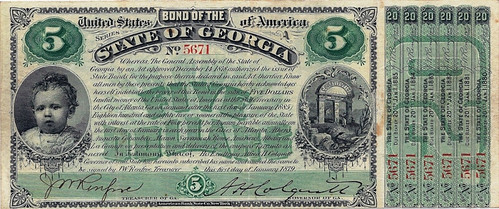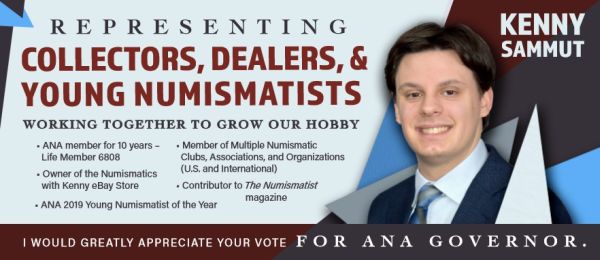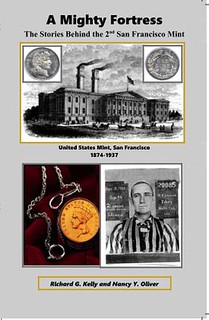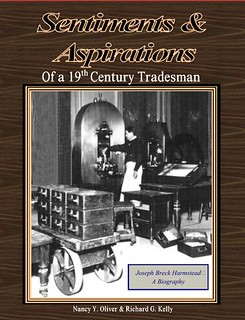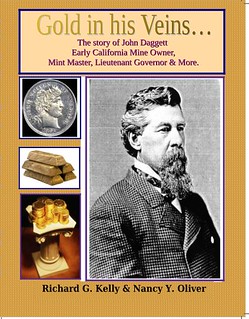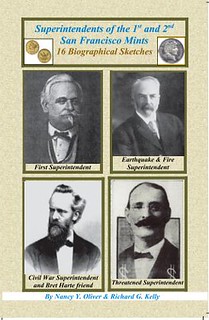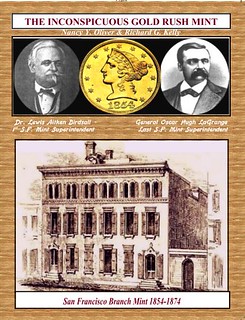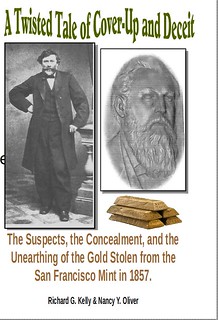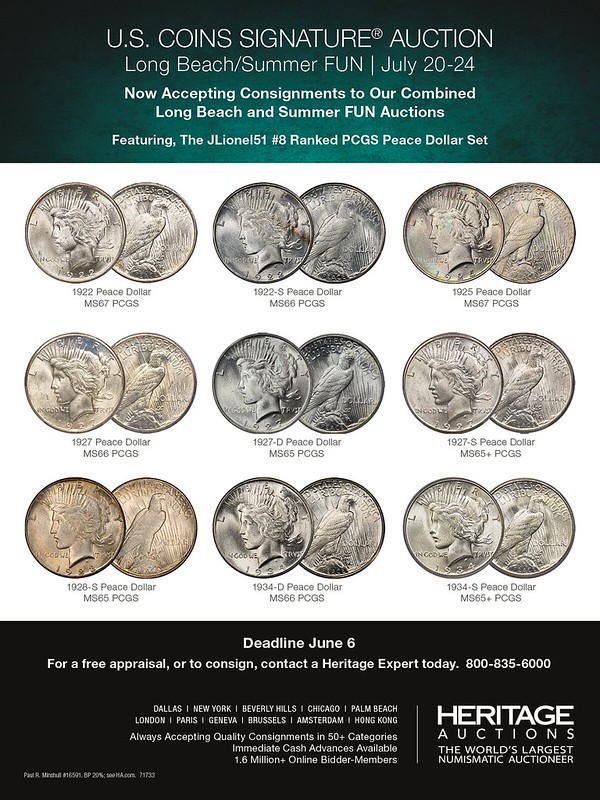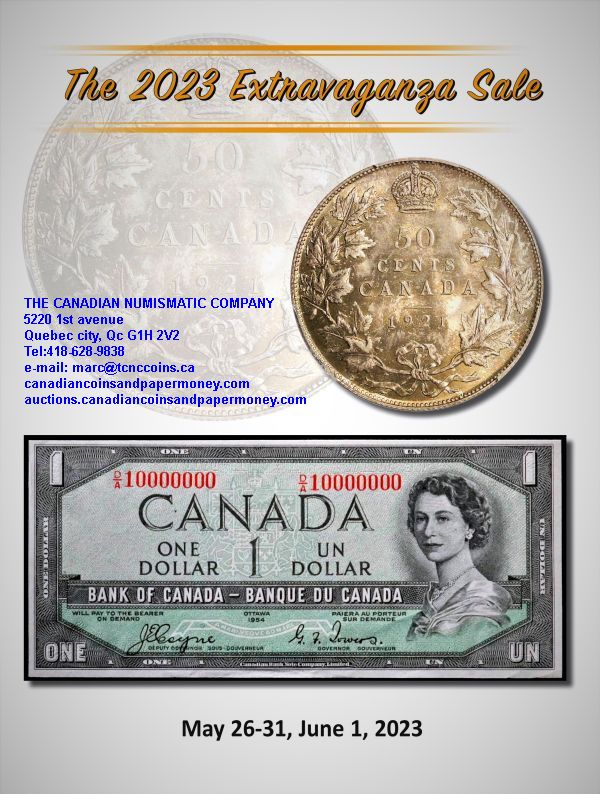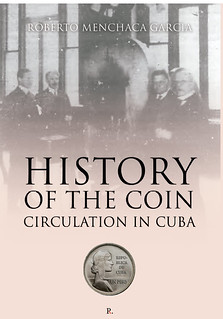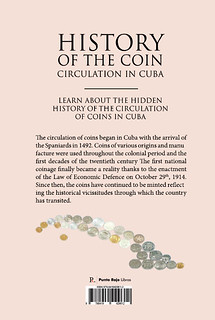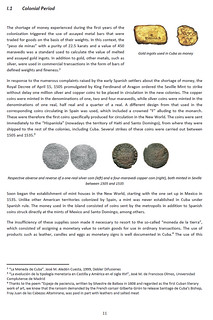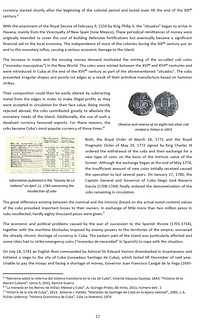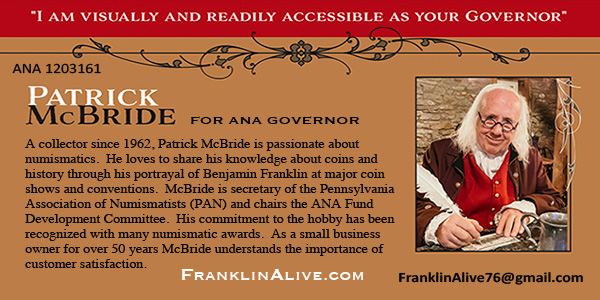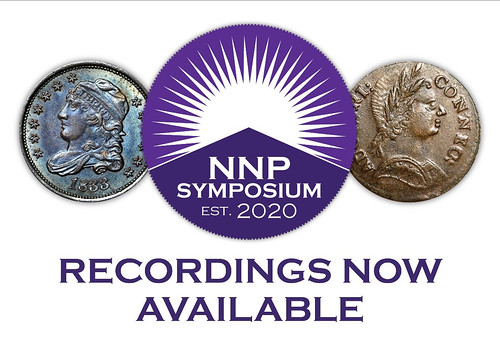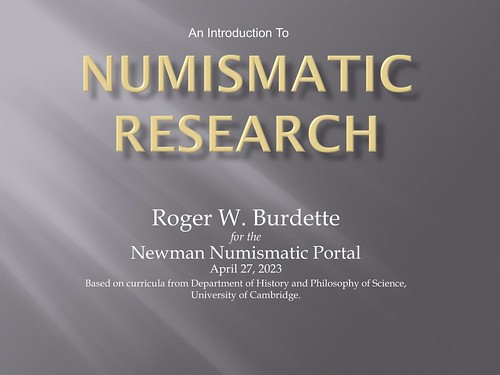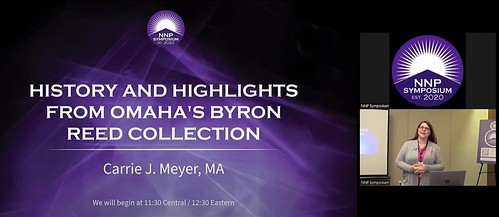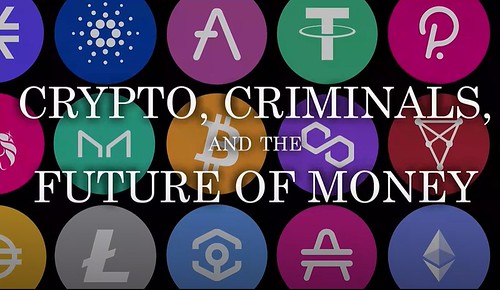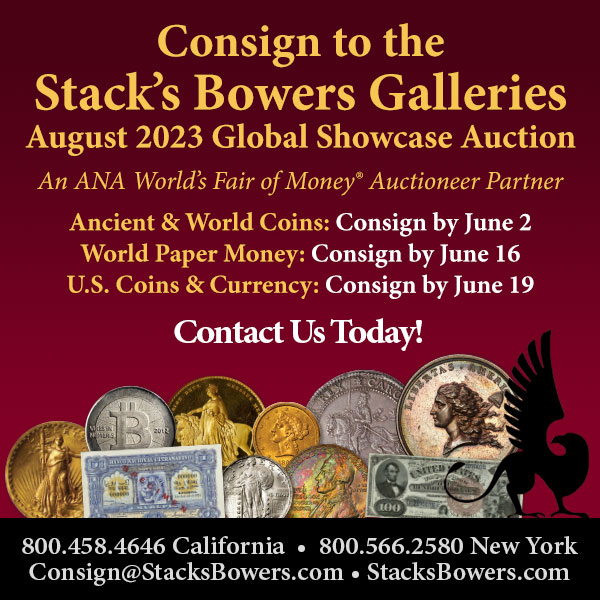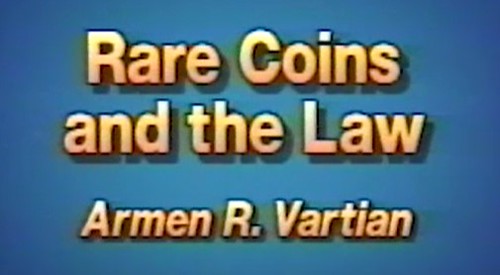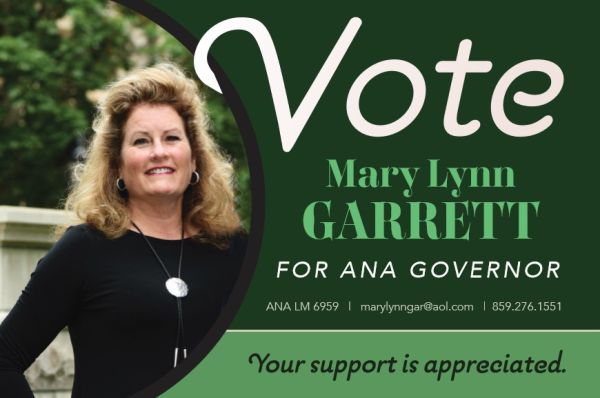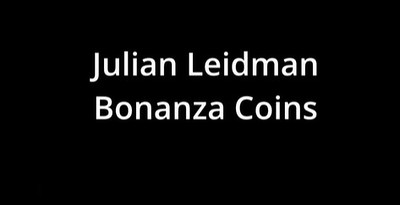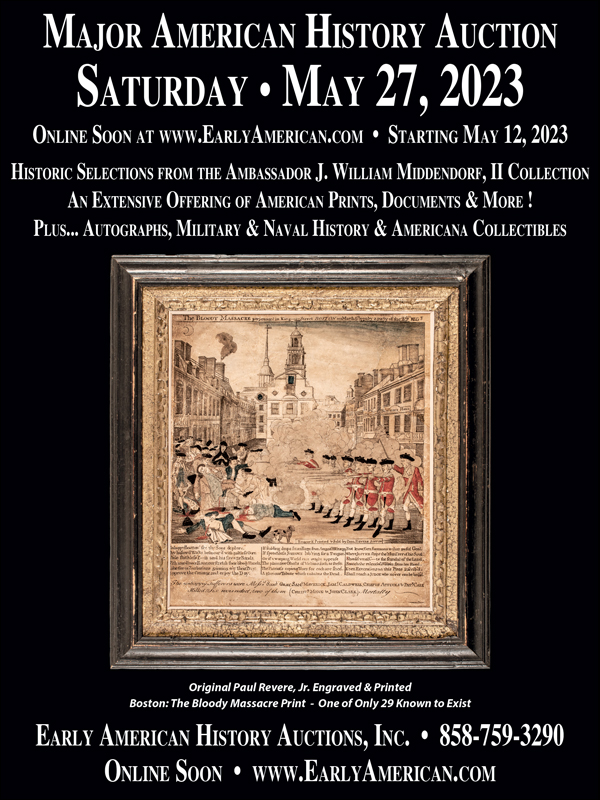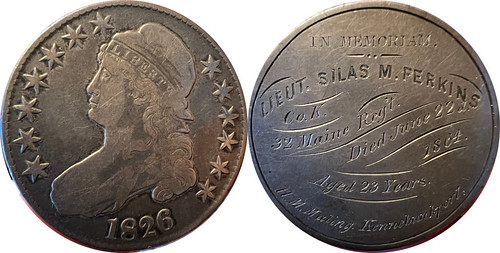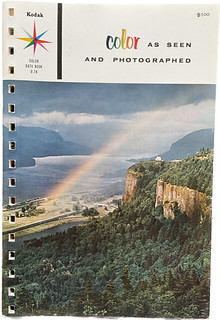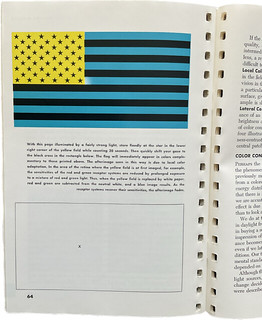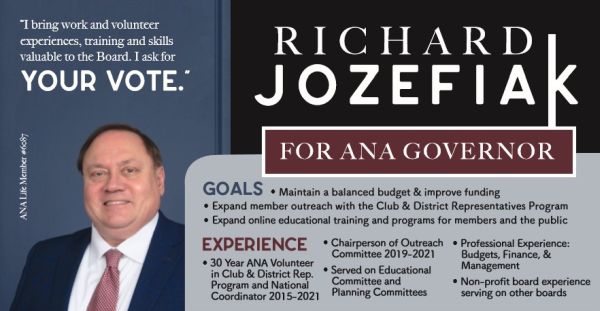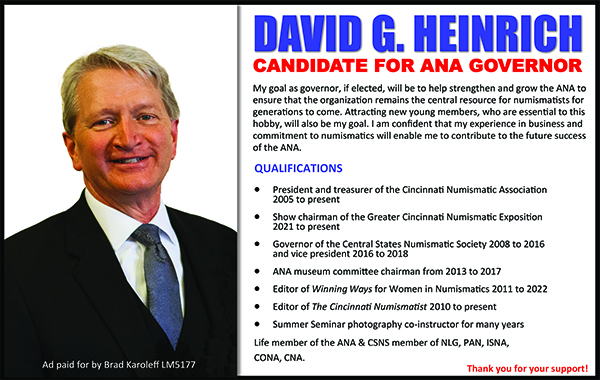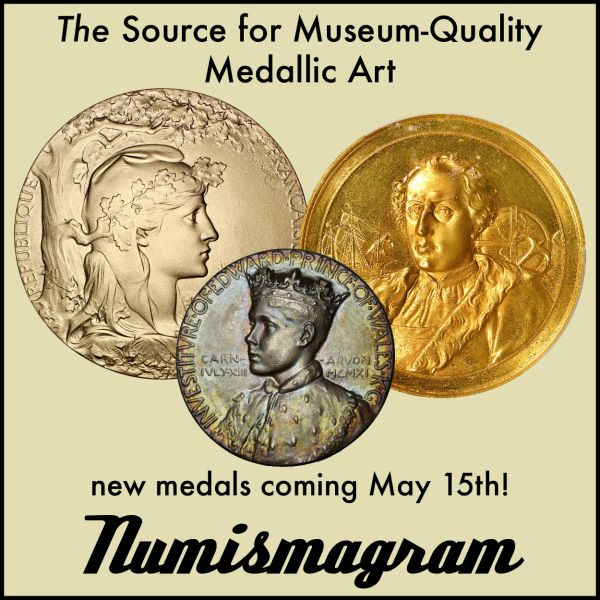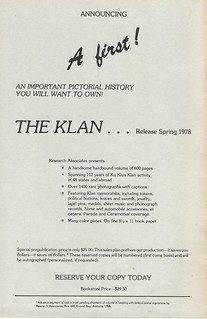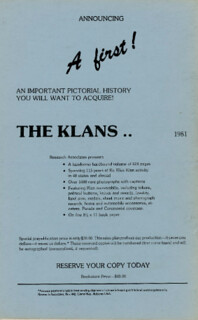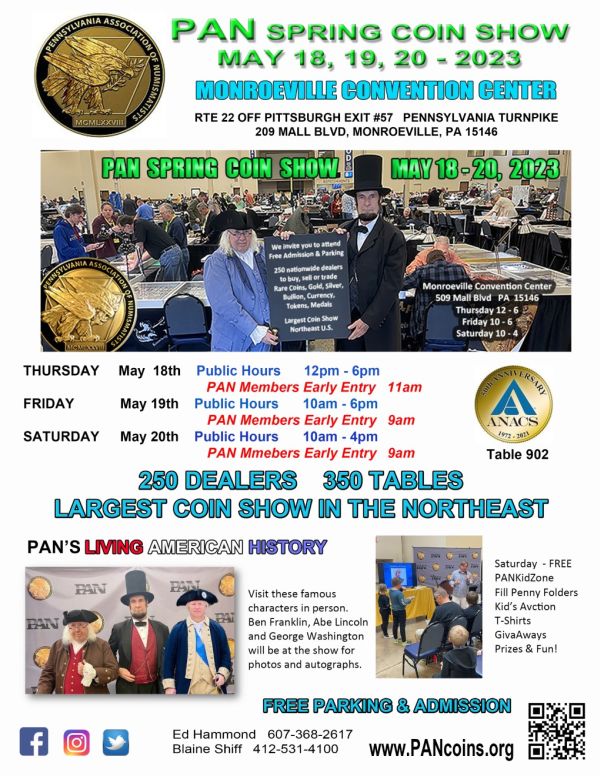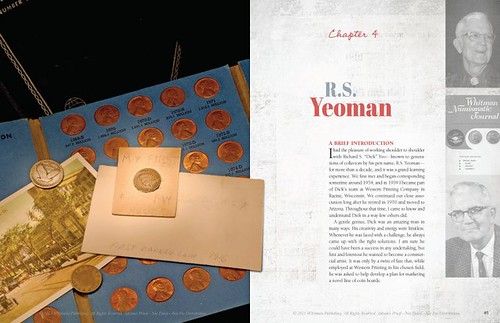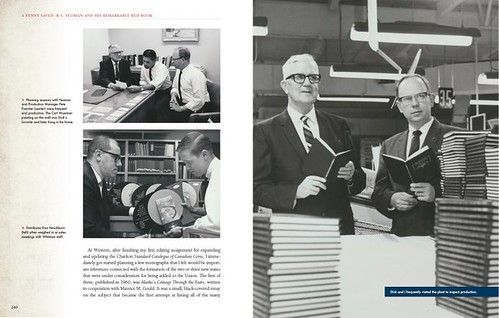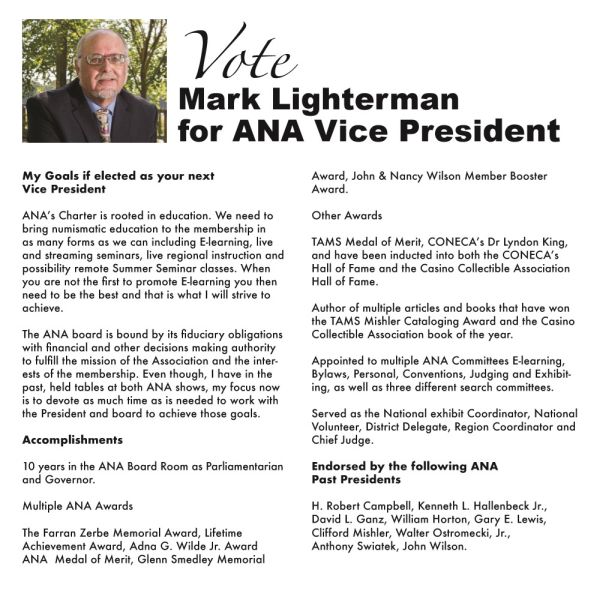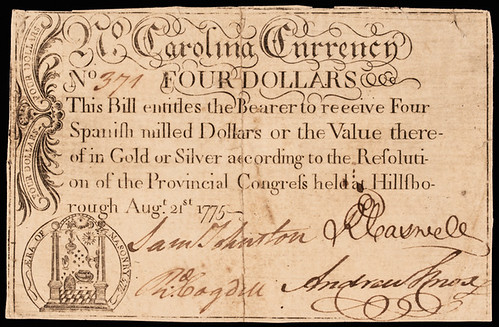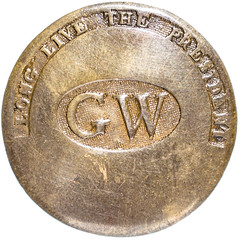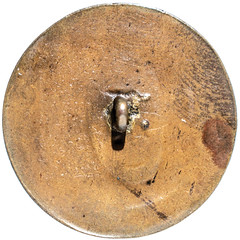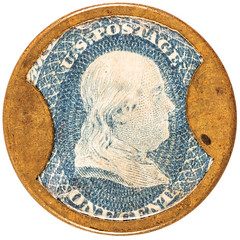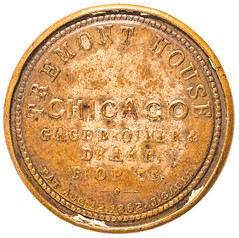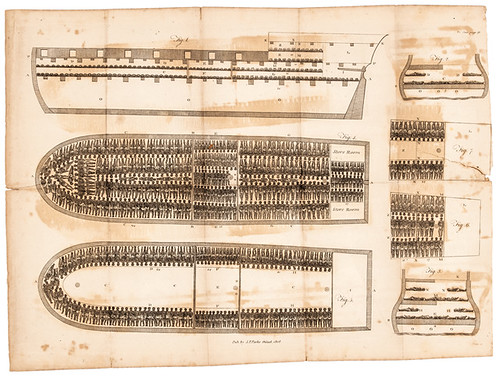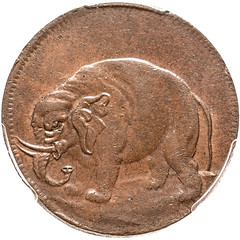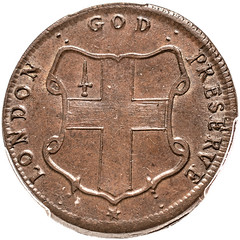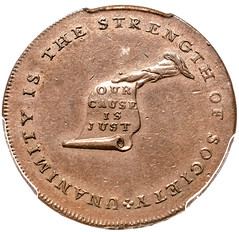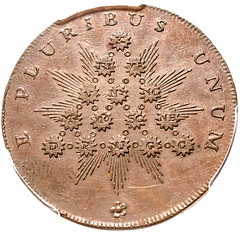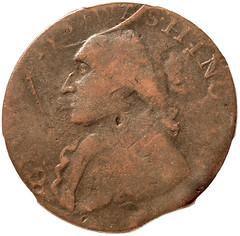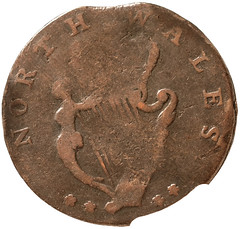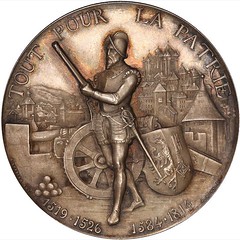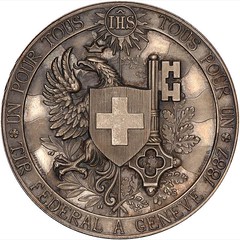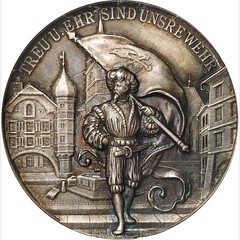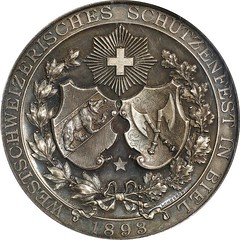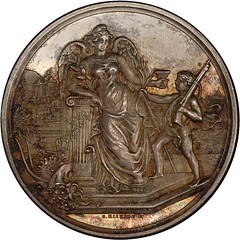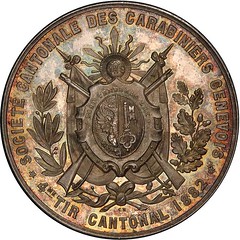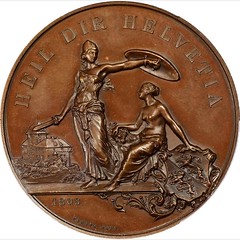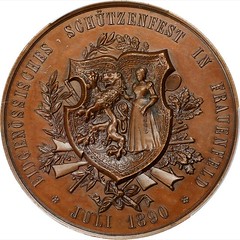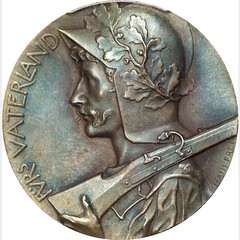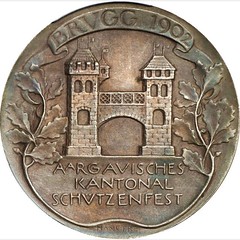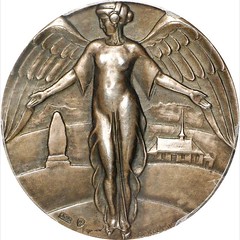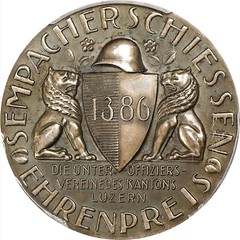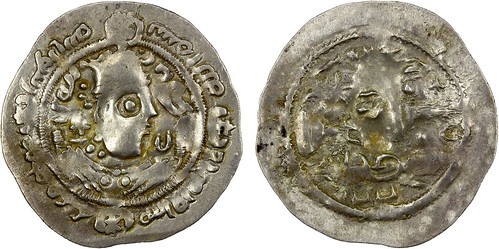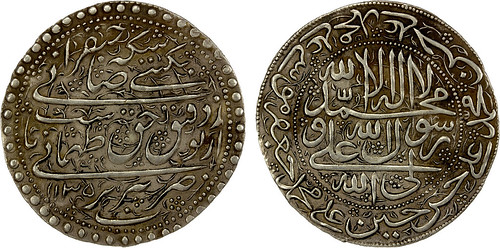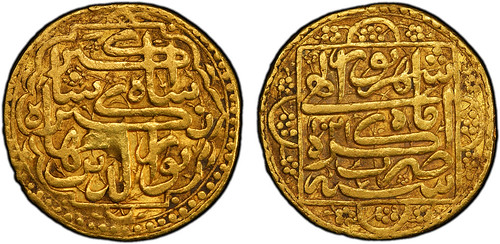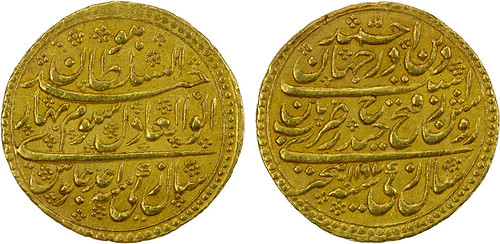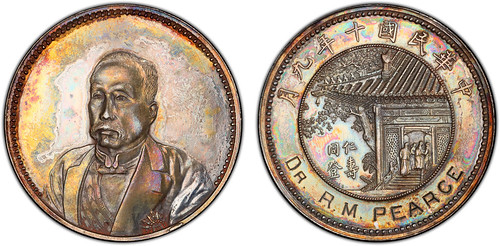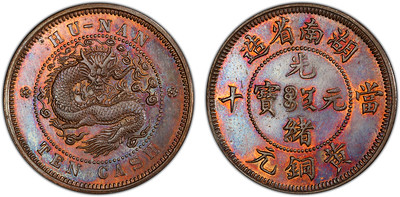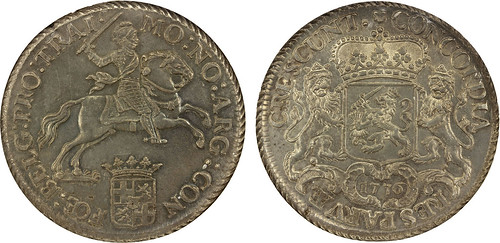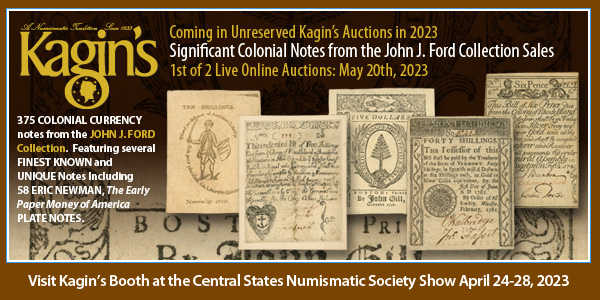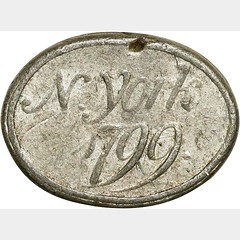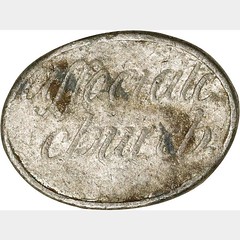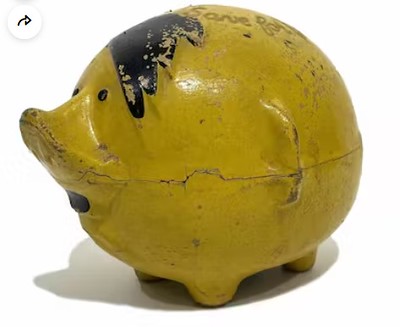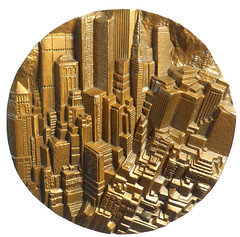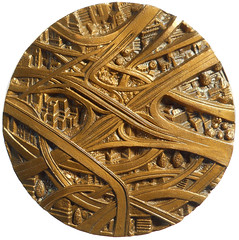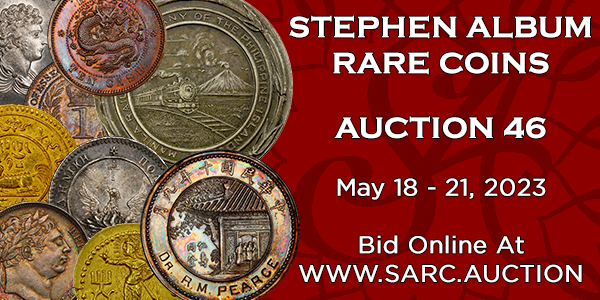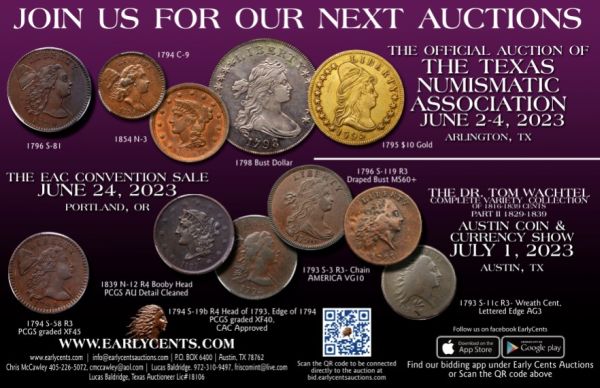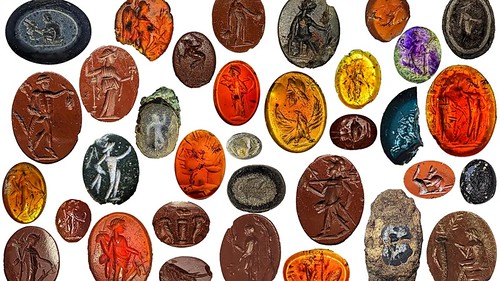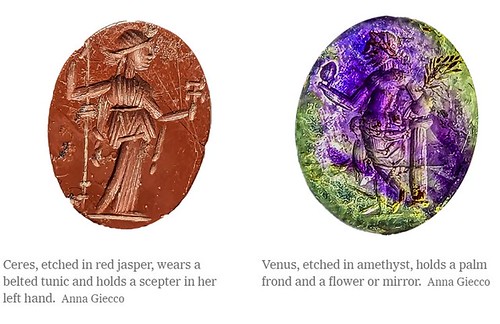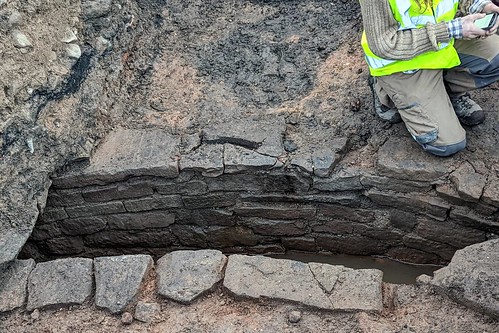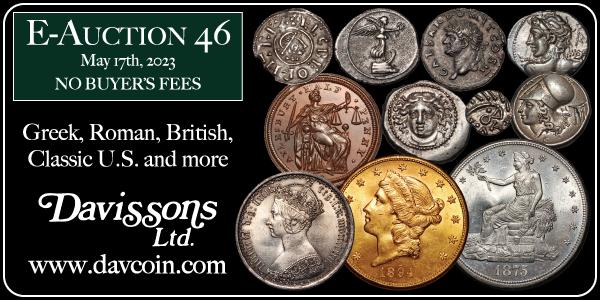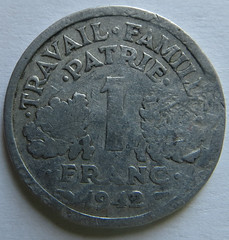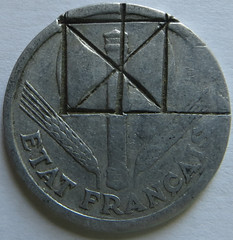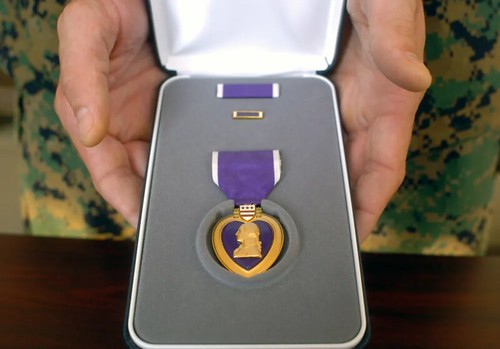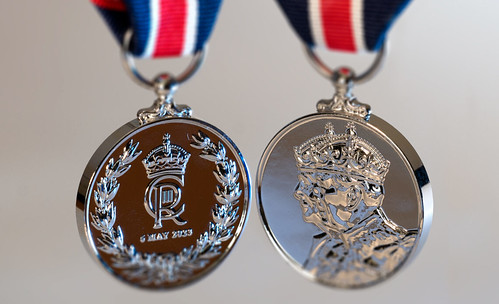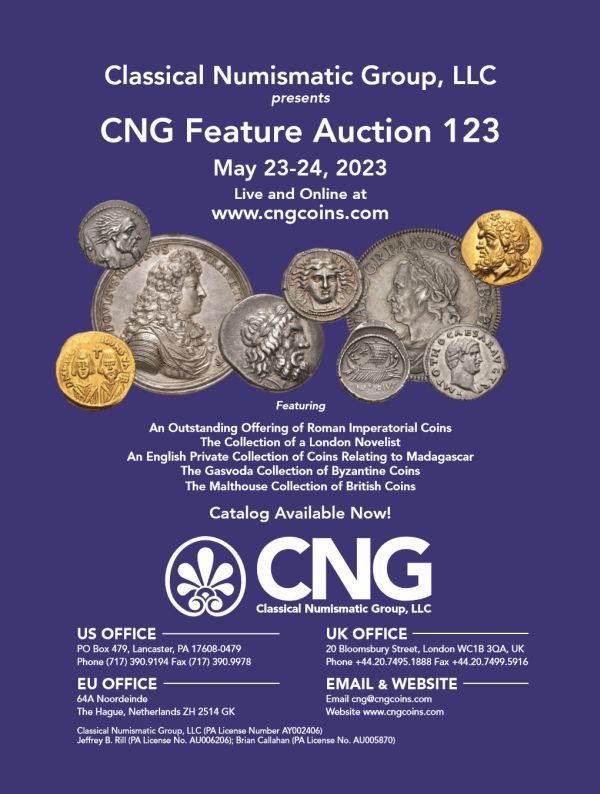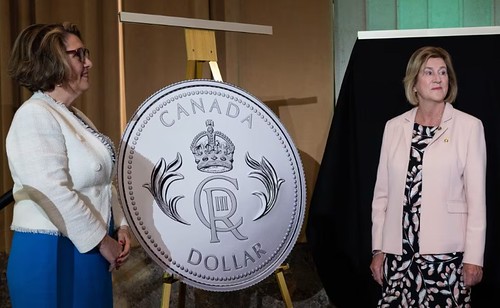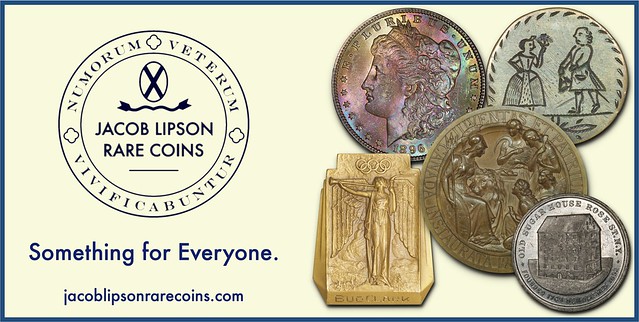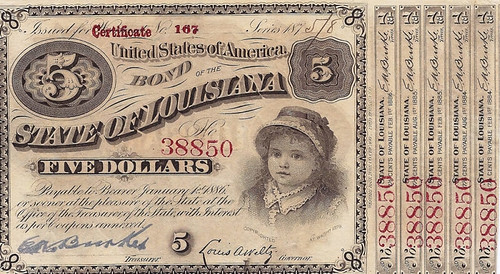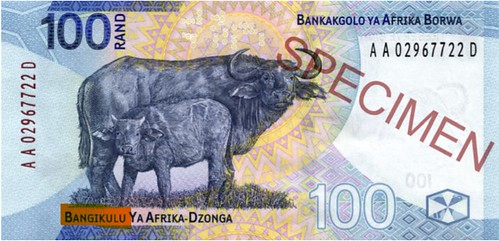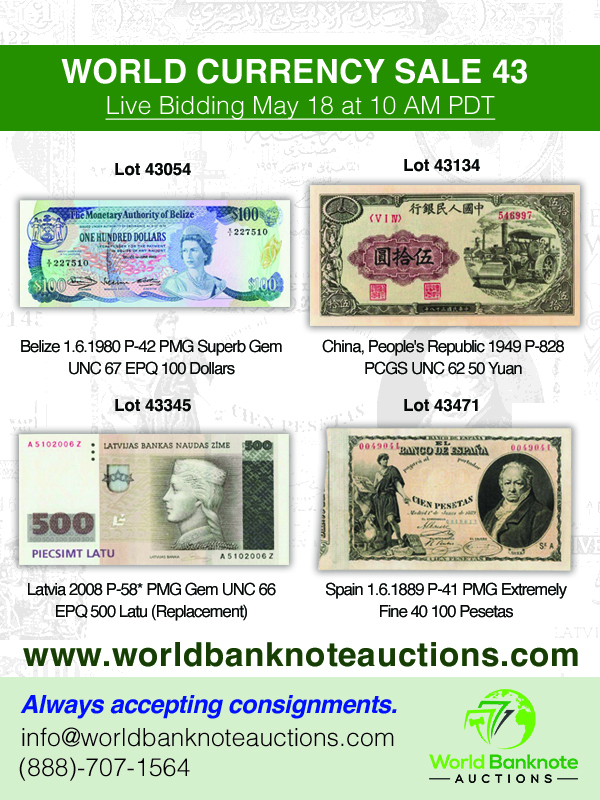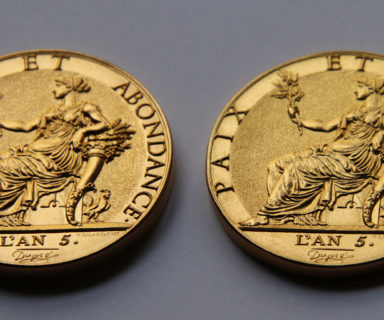
Visit our NBS Sponsors




About UsThe Numismatic Bibliomania Society is a non-profit association devoted to the study and enjoyment of numismatic literature. For more information please see our web site at coinbooks.org SubscriptionsThose wishing to become new E-Sylum subscribers (or wishing to Unsubscribe) can go to the following web page link MembershipThere is a membership application available on the web site Membership Application To join, print the application and return it with your check to the address printed on the application. Print/Digital membership is $40 to addresses in the U.S., and $60 elsewhere. A digital-only membership is available for $25. For those without web access, write to: Charles Heck, Treasurer AsylumFor Asylum mailing address changes and other membership questions, contact Chuck at this email address: treasurer@coinbooks.org SubmissionsTo submit items for publication in The E-Sylum, write to the Editor at this address: whomren@gmail.com BUY THE BOOK BEFORE THE COINSale CalendarKolbe & Fanning sale on May 16, 2023 |
- WAYNE'S WORDS: THE E-SYLUM MAY 14, 2023
- NEW BOOKS: OLIVER-KELLY U.S. MINT HISTORIES
- NEW BOOK: 1839 PHILADELPHIA HALF DOLLARS
- NEW BOOK: HISTORY OF THE COIN CIRCULATION IN CUBA
- APRIL 2023 NNP SYMPOSIUM VIDEOS POSTED
- VIDEO: RARE COINS AND THE LAW
- JULIAN LEIDMAN INTERVIEW, PART ONE
- NOTES FROM E-SYLUM READERS: MAY 14, 2023
- READERS ON THE FADING OF DIGITAL IMAGES
- C4 METAL DETECTING FIND COMPETITION
- VOCABULARY TERM: MONEYER
- DALE ESTIN BIRDSELL (1920-1998)
- THE ORIGINAL AND SECOND
MR. RED BOOK
- ANS CHAIRMAN'S FELLOWSHIP FOR NUMISMATIC RESEARCH
- EARLY AMERICAN HISTORY AUCTION MAY 23, 2023
- PHG SWISS SHOOTING MEDALS SELECTIONS
- STEPHEN ALBUM RARE COINS AUCTION 46
- NUMISMATIC NUGGETS: MAY 14, 2023
- ENGRAVED STONES FOUND IN ROMAN BATHHOUSE
- ROYAL CANADIAN MINT UKRAINE FUNDRAISING
- DEFACED 1942 VICHY 1 FRANC
- THE BADGE OF MILITARY MERIT
- KING CHARLES III CORONATION MEDAL
- KING CHARLES III ON CANADIAN MONEY
- BABY BONDS
- SOUTH AFRICAN BANKNOTE SPELLING SQUABLE
- LOOSE CHANGE: MAY 14, 2023
- FEATURED WEBSITE: ENGRAVER NICOLAS SALAGNAC
Click here to read the thin version on the web
Click here to subscribe
Click here to access the complete archive
To comment or submit articles, reply to whomren@gmail.com
Content presented in The E-Sylum is not necessarily researched or independently fact-checked, and views expressed do not necessarily represent those of the Numismatic Bibliomania Society.
WAYNE'S WORDS: THE E-SYLUM MAY 14, 2023
 New subscribers this week include:
Richard Kelly & Nancy Oliver.
Welcome aboard!
New subscribers this week include:
Richard Kelly & Nancy Oliver.
Welcome aboard!
Thank you for reading The E-Sylum. If you enjoy it, please send me the email addresses of friends you think may enjoy it as well and I'll send them a subscription. Contact me at whomren@gmail.com anytime regarding your subscription, or questions, comments or suggestions about our content.
This week we open with eight new and updated books, NNP Symposium videos, a new interview, notes from E-Sylum readers, and more.
Other topics this week include circulating coins in Cuba, rare coins and the law, digital images, colonial coin metal detecting finds, Julian Leidman, Dale Birdsell, the Misters Red Book, auction previews, bathhouse finds, the Badge of Military Merit, Charles III medals and money, and Baby Bonds.
To learn more about San Francisco Mint history, 1839 Philadelphia Half Dollars, slave quarters, the Byron Reed collection, cryptocurrency, Mega Red, Moneyers, Swiss Shooting Medals, the Pavilion Dollar, and how U.S. coin dies got their numbers, read on. Have a great week, everyone!
Wayne Homren
Editor, The E-Sylum
THE BOOK BAZARRE
NEW BOOKS: OLIVER-KELLY U.S. MINT HISTORIES
Nancy Oliver and Richard Kelly have revised and reprinted all six of their books on U.S. Mint history. That's great news! Here's the announcement. -Editor
Nancy Oliver and Richard Kelly, co-authors of the Numismatic Chronicles column in The Numismatist, have revised and reprinted all six of their books. They lost their home and all of their belongings to the 2018 Paradise, Ca, fire. However, a recently discovered USB drive containing all the book files (found in a surviving safe deposit box) has made recovery, revision, and reprinting possible. The following books have been updated and limited copies are available for purchase:
- A Mighty Fortress - the Stories Behind the 2nd San Francisco Mint.
- Sentiments and Aspirations of a 19th Century Tradesman (Joseph Breck Harmstead - Coiner) - a Biography.
- Gold in His Veins - the Story of John Daggett (SF mint Supt & the 1894 S Dime).
- Superintendents of the 1st and 2nd San Francisco Mints - 16 Biographical Sketches.
- The Inconspicuous Gold Rush Mint - the 1st San Francisco Mint's history.
- A Twisted Tale of Cover-Up and Deceit - the Suspects, the Concealment, and the Unearthing of the Gold Stolen from the 1st San Francisco Mint in 1857.
Book prices run from $14.95 to $29.95. To purchase a copy of any work, please contact the authors at nancyoliver4714@comcast.net .
To read the earlier E-Sylum articles, see:
FIRE AFFECTS AUTHORS RICH KELLY AND NANCY OLIVER
(https://www.coinbooks.org/v21/esylum_v21n48a07.html)
THANKS FROM RICH KELLY AND NANCY OLIVER
(https://www.coinbooks.org/v22/esylum_v22n25a08.html)
NEW BOOK: 1839 PHILADELPHIA HALF DOLLARS
Jim Koenings has published a new book, "The Koenings Collection of 1839 Philadelphia Half Dollars, Including Liberty Seated Half Dollars". Congratulations! Here's his announcement. -Editor
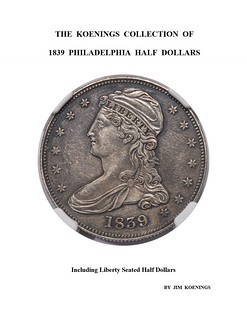 At right is the cover page of my new book on 1839 Half Dollars.
To the best of my knowledge this new book is the only complete collection of all 15 die marriages for the year 1839. This book has all 8 known die marriages of 1839 Capped Bust Reeded Edge Half Dollars including the highest graded certified specimen of 1839 GR-1 in NGC AU50. It also includes all 7 Liberty Seated Half Dollar die marriages.
At right is the cover page of my new book on 1839 Half Dollars.
To the best of my knowledge this new book is the only complete collection of all 15 die marriages for the year 1839. This book has all 8 known die marriages of 1839 Capped Bust Reeded Edge Half Dollars including the highest graded certified specimen of 1839 GR-1 in NGC AU50. It also includes all 7 Liberty Seated Half Dollar die marriages.
I have been a member of John Reich Collectors Society (JRCS) since June of 1986 and a member of Liberty Seated Coin Club (LSCC) since November 2020. I bought my first Reeded Edge Half Dollar in November 2009 and by November 2017 I had 53 of the 56 known die marriages. Since then, I have become a very serious die stage collector and believe my collection of Reeded Edge Halve is the most complete in the world.
In August 2022, I purchased my first 1839 Liberty Seated Half Dollar, an 1839 WB-6 in PCGS XF45 in a Heritage Auction and hoped to find the remaining 6 die marriages in the same grade. That didn't happen. However, eight months later, I did find them in reasonable grades and they are now shown in my new book.
It has been 11 years since Dick Graham printed his book A Registry of Die Varieties of Reeded Edge Half Dollars 1836-1839
. Things change, rarities change and new information has been learned.
This book The Koenings Collection of 1839 Philadelphia Half Dollars, including Liberty Seated Half Dollars
is my attempt to inform all collectors of the opportunities available for the year 1839. It includes numerous die stages of 1839 die marriages including newly discovered information on 1839 GR-8's with Greatly Rotated reverses.
The book also covers the history of previous authors and includes extra large photos of each obverse and reverse (6 in diameter). It is 8.5 x 11 and has protective Mylar covers along with spiral binding that allows you to open the book and lay it flat to see both pages of a particular die marriage. There are more than 71 pages plus indexes and a total of 65 extra large photos.
It is now available to JRCS members, LSCC members and all collectors for $39 plus $4 for shipping and handling. Only 100 copies have been printed. If you would like a copy, please send a check or money order to:
Jim Koenings
P.O. Box 2382
Riverside, CA 92516
If you would like your copy sooner, you can send payment of $43 through Paypal to my email address of bustcoin1@verizon.net.
Happy Hunting!
Jim adds:
"Anyone can receive my free Newsletters by simply sending their email address to me. Many of my Newsletter readers bought my first book on Reeded Edge Halves five years ago. Currently there are about 120 collectors that receive my Newsletters of which many are JRCS and LSCC members."
NEW BOOK: HISTORY OF THE COIN CIRCULATION IN CUBA
Roberto Menchaca has published a new book on circulating Cuban coinage. Congratulations! Here's his announcement. -Editor
My new book HISTORY OF THE COIN CIRCULATION IN CUBA
(Roberto Menchaca García, Editorial Punto Rojo Libros, 2023) has just been published.
The book is the continuation of an earlier work published in 2013, "La moneda cubana en circulación" (The Cuban coins in circulation
; see also E-Sylum, vol. 16, nr. 33, Aug. 10, 2013), and delves into the study of the historical context in which the various types of coins have been produced in the country. To this aim, an extensive bibliographic research was carried out, covering inter alia numerous newspapers and magazines, official reports and the information contained in the archives of the Numismatic Museum of Havana.
The first chapter is devoted to the general study of the coinage made in each of the periods, that the Cuban history can be divided. The following chapters detail the characteristics of the various coins produced since 1915 till present. The coinage produced on behalf of the National Institute of Tourism and the convertible currency are discussed in a subsequent chapter.
The book further includes annexes containing detailed information on other coins of great significance in the history of Cuba, the use of countermarks in the island as well as the technical specifications of the coins discussed and the legal provisions authorising the coinage.
The book can be purchased online at several libraries (www.todostuslibros.com; www.libros.cc; www.elkar.eus; soon too in: www.amazon.es; www.fnac.es; www.casadellibro.com), on the web page of the editorial house (www.puntorojolibros.com) or it could be directly ordered with the author (romega73@yahoo.es). Both, a paper copy or an electronic version can be ordered.
Please note, that the Spanish version of the book, APUNTES HISTORICOS SOBRE LA CIRCULACION DE LA MONEDA EN CUBA (Roberto Menchaca García, Editorial Punto Rojo Libros, 2023), has also been published.
APRIL 2023 NNP SYMPOSIUM VIDEOS POSTED
The latest additions to the Newman Numismatic Portal are videos from the recently held NNP Symposium. -Editor
Recordings from the NNP Symposium are now available on the Newman Numismatic Portal! You can go back to watch any talks that you missed and share them with others.
If you want to search through past presentations, we have an Excel spreadsheet on our website that will help you filter through all 170+ past recordings!
Link to 2023 NNP Symposium video on Newman Portal:
https://nnp.wustl.edu/library/multimediadetail/539070?Year=2023&take=50
For an Excel spreadsheet of all past presentations, see:
https://nnpsymposium.org/past-recordings?mc_cid=b0baa24af3&mc_eid=90750fdec9
To read the earlier E-Sylum article, see:
APRIL 2023 NNP SYMPOSIUM ANNOUNCED
(https://www.coinbooks.org/v26/esylum_v26n06a09.html)
VIDEO: RARE COINS AND THE LAW
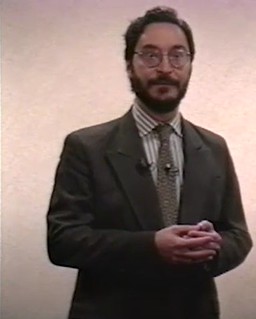
The David Lisot Video Library on the Newman Numismatic Portal can be found at:
https://nnp.wustl.edu/library/multimediadetail/522852
We highlight one of his videos each week in The E-Sylum. Here's one from 1997 with attorney Armen R. Vartian. -Editor
Armen is an attorney who specializes in numismatics. Speaker(s): Armen R. Vartian.
To watch the complete video, see:
https://nnp.wustl.edu/library/book/560406
JULIAN LEIDMAN INTERVIEW, PART ONE
Greg Bennick's latest interview for the Newman Numismatic Portal is with dealer Julian Leidman. Here's the first part, where Julian talks about first getting interested in coins. -Editor
Greg Bennick: Hi, everybody. I'm Greg Bennick with the Newman Numismatic Portal, and this is another interview. And not just another interview, it's a great interview in a series of interviews that I'm doing for the NMP. Today, I'm with Julian Leidman. Julian is from Bonanza Coins in Silver Springs, Maryland. Julian is a lifetime member of the ANA. He also received a Lifetime Achievement Award from the Professional Numismatist Guild, PNG, and also from the ANA. So, this is a special interview, and I'm very excited about it. Julian, thanks for taking some time and being with me today.
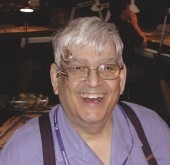 Julian Leidman: Happy to do it, Greg. Thank you.
Julian Leidman: Happy to do it, Greg. Thank you.
Greg Bennick: Awesome. Well, let's get started with the basics, because I always love the basics and everyone's background story. Tell me, how did you get started in coin collecting? Where did it all begin?
Julian Leidman: It began in the 1950s. We had just gotten a television in the house, and my parents decided they had to get me out from the television. So, they said, ‘Why don't you try a hobby?' And the first thing I tried was stamps, and it didn't go very well. And then my mother showed me some coins, and that was more interesting. And that went well.
Greg Bennick: This is great because when I started collecting, my father tried to get me interested in stamps to start, and I had no interest in it whatsoever. And I immediately gravitated towards coins. Similar background story, in a way. So, what were the coins that you collected first? What were the first coins that you collected that you enjoyed?
Julian Leidman: Well, I lived in upstate New York, in Troy, New York, which isn't so far from Canada. But I started with the basic stuff, Lincolns and Jeffersons. I also probably collected Canadian small cents at the time too. I started just a very basic beginning collection.
Greg Bennick: So, when was it that that very basic beginning collection took a step forward? What were the moments or the coins themselves that made that basic collection of cents, say, in a Whitman album, and took that to the next level?
Julian Leidman: You know, as I would look through coins, and find coins that I needed, and find coins that maybe some of my friends needed, it did kick up a little bit. The next major event for me, really, was as I was a sophomore in high school, my father got transferred to Washington DC, Veterans Administration. And since I was 15 at the time, I went. And then when I got to Maryland, I kinda realized, well, I kinda left my friends at home, in Troy, and so the coins picked up even more. I met my long-time friend and colleague Al Bonan, who had Bonanza Coins, and his store was a mile from my high school. And of course, I wasn't driving, but I was hitchhiking. So, I would go over to the store and do various little things, all the time looking through coins, and finding other coins. And that's really where the focus was at the time.
Greg Bennick: Now, over the years, you've played the roles of dealer, researcher and collector, representative for folks in auctions. And I know that you've gone to auctions throughout your entire life. And I wanted to maybe touch on the three of those to start. And first, as a dealer, you've had this incredible career with Bonanza, and have been to major coin shows over the last - I'm assuming - probably over the last 50 years or so. So, with that in mind, what are your favorite coins that you've handled over the years? Are there any in particular that stand out?
Julian Leidman: Well, when I started going to coin shows, it was actually in the - I actually think I went to my first coin show in 1964 or 1965. And it was either... I think it was the Blue Ridge Numismatic Association convention in Charlotte, North Carolina. And interestingly enough, at the time, they had teletypes on the floor of the convention. This is teletype, this isn't - and they actually had machines there, buying and selling. There was a lot of wheeling and dealing. Of course, the wheeling and dealing was in a different kind of coin than I was normally interested in. I had kinda gravitated toward beautiful coins. I liked really pretty coins, and buying and selling, and going around there. The next big show I can think of attending was the Metropolitan Washington Numismatic Association convention, the very first one.
And that was at the old Sheraton Park Hotel in Washington. And it was held in the ballroom with a grand staircase coming down into the bourse room. The bourse room was... I don't know, maybe 50 or 60 dealers. It was something impressive for me, and of course impressive because of the fact that it's in the grand ballroom of the Sheraton Park. And I was able to go around and meet more dealers. I had already met my local dealers. The big ones were Ben Douglas and Jack O. King. Jack had a table at the convention, and he had a little sign in his case that said ‘All prices are firm,' which was interesting. But I grew pretty close to Jack, and over the years I did some very nice business with him. He was a coin and stamp dealer, and I enjoyed him. And of course, I knew Ben very well. And after Ben passed away, his sister gave me the balance of his coins to market for them.
And I did that for many, many years, really. I've always been a very patient person, patient in buying and patient in selling. Patience is really critical in numismatics, I feel. You can't necessarily jump on the first one, unless you have the experience to know the first one may be the only one. And so, that's something that I learned over the years.
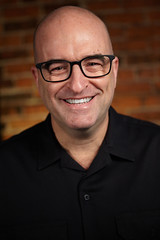 About the Interviewer
About the Interviewer
Greg Bennick (www.gregbennick.com) is a keynote speaker and long time coin collector with a focus on major mint error coins. Have ideas for other interviewees? Contact him anytime on the web or via instagram @minterrors.
To watch the complete video, see:
Julian Leidman Interview
(https://nnp.wustl.edu/library/book/626691)
To read the complete transcript, see:
Julian Leidman Interview (Transcript)
(https://nnp.wustl.edu/library/book/626692)
NOTES FROM E-SYLUM READERS: MAY 14, 2023
More on the Weimar White Seated Dollar Books
Ken Berger writes:
"I have the soft covered version of the book "The Liberty Seated Dollar 1840-1873" by Weimar W. White. It does not contain a signature."
Thanks. -Editor
To read the earlier E-Sylum article, see:
NOTES FROM E-SYLUM READERS: MAY 7, 2023 : Query: Weimar White Liberty Seated Dollar Book Signature
(https://www.coinbooks.org/v26/esylum_v26n19a14.html)
Notes From Ken Bressett
Ken Bressett writes:
"Another great issue of The E-Sylum. Don't know what I would do on Mondays without it. Here are a couple of items that caught my eye, besides the greatly-appreciated article about my book on Bible Lore, and the imprimatur.
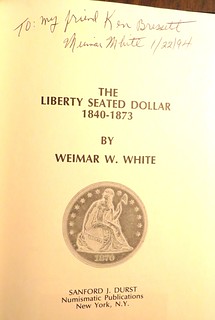 "My copy of the hard-bound Durst book by Weimar White has the pasted in autograph label and #34 of 500. It also has his autograph on the title page where it is autographed to me and dated 1/22/1994. I knew him well, and am sure that both are his actual autographs. Here is a regrettably lousy picture of the title page autograph.
"My copy of the hard-bound Durst book by Weimar White has the pasted in autograph label and #34 of 500. It also has his autograph on the title page where it is autographed to me and dated 1/22/1994. I knew him well, and am sure that both are his actual autographs. Here is a regrettably lousy picture of the title page autograph.
"I can also verify that the English ‘dump' copper coins are struck and not cast.
"I also greatly enjoyed and appreciated Newman's research on the Bar coppers. It brought back some fond memories."
It's great to hear from you - glad you enjoyed the issue. Thanks for all you do as well. Readers - see the article elsewhere in this issue about Ken's great work with R.S. Yeoman on the Red Book. -Editor
To read last week's complete issue, see:
Volume 26, Number 19, May 7, 2023
(https://www.coinbooks.org/v26/club_nbs_esylum_v26n19.html)
Standard Works for Various Coin Series
Ken White writes:
"While reading the current issue of E-Sylum and the Weimer W. White article in particular I wondered if there was a published list available for all the various coin designs and or denominations. In other words, what books are recognized as the standard reference for their types?"
Well, my own go-to list for that would be the latest edition of the Red Book, A Guide Book of United States Coins. See the Bibliography in the back. By necessity the editors and publisher must keep up with all the latest published research and information. If a book is listed there, it's a keeper. Even if it's an oldie, it's still a goodie. Of course, space limitations keep that list very short. There are many excellent works that don't make that cut.
We do have a bibliography section on the NBS Wiki. Here's the U.S. section: http://wiki.coinbooks.org/index.php/Category:United_States .
It hasn't been updated in some time, and there have been a lot of great new titles published since then. Time to recruit a volunteer to help!
I also reached out to Dennis Tucker at Whitman, and got pointed to a great reference I'd overlooked, even though there's a copy sitting right here under my big fat nose. Here's his response. -Editor
In Mega Red we try to maintain an expanded and up-to-date bibliography, with the annual help of David Fanning and others. For 21 main categories it includes
-
Standard References
--books defined by Q. David Bowers and his contributors as beingessential today
(this includes many updated/revised editions of past writing and research), and -
References of Historical Interest
(defined astitles from the past that for the most part have been made obsolete by later writing and research
). These are further described:Some of these remain valuable as a window into the state of the art years ago; they often contain anecdotal and narrative text not included in later works.
The categories covered are:
-
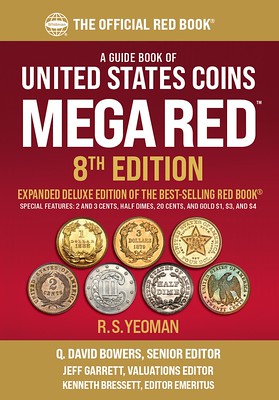 Colonial and State Coinage (by far the largest, with a page and a half of
listings)
Colonial and State Coinage (by far the largest, with a page and a half of
listings)
- Half Cents
- Large Cents
- Small Cents
- Two-Cent Pieces and Three-Cent Pieces
- Nickel Five-Cent Pieces
- Half Dimes
- Dimes and Twenty-Cent Pieces
- Quarter Dollars
- Half Dollars
- Silver and Related Dollars
- Gold Coins ($1 through $20)
- Commemorative Coins
- Bullion Coins
- Pattern Coins
- Private and Territorial Gold
- Tokens, Medals, and Exonumia
- General Works Covering Multiple American Coin Series
- World Issues Related to the United States
- History of the U.S. Mints and the Mint Collection
- Publications About Books, Coinage, Money, and Numismatics
To read the earlier E-Sylum articles, see:
NEW BOOK: MEGA RED 8TH EDITION
(https://www.coinbooks.org/v25/esylum_v25n36a04.html)
NOTES FROM E-SYLUM READERS: MAY 7, 2023 : Query: Weimar White Liberty Seated Dollar Book Signature
(https://www.coinbooks.org/v26/esylum_v26n19a14.html)
Silas M. Perkins Memorial Engraved Half Dollar
Alan Weinberg published this interesting coin image in today's JR Newsletter from the John Reich Collectors Society, wondering if the honoree was related to engraver Jacob Perkins or NBS board member Dave Perkins. Nice piece. -Editor
"Silas M. Perkins died of wounds sustained at Cold Harbor on May 31, 1864. He was accidentally shot in the foot while in his tent. He is buried at Village Cemetery in Kennebunkport, Maine.
"Silas was the son of Silas P. Perkins (1803-1883) and Eliza A. Foss (1810-1862).
"He was the grandson of Stephen Perkins (1765-1833) and Alice Stone (1769-1850).
"He was the great grandson of Abner Perkins (1730-1811) and Anna Perkins."
Alan Weinberg adds:
"The fact that an accidental shooting of a foot would result in death during the Civil War speaks volumes of the status of medical science and the availability of emergency medical treatment during the Civil War during which limb amputations were reportedly widespread."
READERS ON THE FADING OF DIGITAL IMAGES
Several readers have chimed in on Peter Huntoon's question about the fading of digital images. Bob Van Arsdell opens with the visual aspect. -Editor
Bob writes:
"In 1950, Eastman Kodak published a booklet Color as Seen and Photographed
. It's one of the best introductions to color vision and the problems of color reproduction processes.
"Copies are usually available on eBay for a nominal amount - go for the second edition.
"If you take the Flag Test
on page 64, you'll never believe anything you see for the rest of your life. The image here probably won't work, so you'll need the book."
Bob adds:
"Some of your answers may be found in this Wikipedia article. It's just the tip of the iceberg, though.
https://en.wikipedia.org/wiki/Color_management?wprov=sfti1."
In digital imaging systems, color management (or colour management) is the controlled conversion between the color representations of various devices, such as image scanners, digital cameras, monitors, TV screens, film printers, computer printers, offset presses, and corresponding media.
The primary goal of color management is to obtain a good match across color devices; for example, the colors of one frame of a video should appear the same on a computer LCD monitor, on a plasma TV screen, and as a printed poster. Color management helps to achieve the same appearance on all of these devices, provided the devices are capable of delivering the needed color intensities. With photography, it is often critical that prints or online galleries appear how they were intended. Color management cannot guarantee identical color reproduction, as this is rarely possible, but it can at least give more control over any changes which may occur.
Parts of this technology are implemented in the operating system (OS), helper libraries, the application, and devices. A cross-platform view of color management is the use of an ICC-compatible color management system.
Bob continues:
"The first Wikipedia article I sent outlines the problems when one person looks at a color monitor and sees a color.
"This article outlines the problems when one person looks at a color monitor over time, or two people look at a monitor and compare their experiences.
Len Augsburger of the Newman Numismatic Portal writes:
"A .jpg file, like any other computer file, is simply a series of 0s and 1s. The question is this – does that precise sequence of 0s and 1s change over time, if the file is not deliberately modified? The answer, barring hard drive or memory chip failures, is no. Civilization as we know it would collapse tomorrow were the opposite true. The billions of computer chips that power our entire infrastructure all have designs that can be expressed as a series of 0s and 1s. If that precise series randomly degrades, chaos ensues.
"That said, the way these strings of 0s and 1s are interpreted may well change over time. The software behind .jpg readers constantly changes, as does display technology. Human perception changes too, as anyone who has looked at coins for a long time knows. You simply see things differently the more experienced you are."
Roger Burdette writes:
"With regard to Peter Huntoon's problem of "fading digital images," Doug Mudd's comment is correct one. The policy I use is the same as at any archival facility: the master image is always stored in as a read-only TIFF (lossless) format and in two unconnected data centers. For critical use, the master image is copied, bit-checked, and then used locally. The copy can be stored and used locally but never goes back to the original location. A highest-quality JPEG is used for pre-publication work with the understanding that a JPEG is not stable and is subject to change every time it is saved.
"Bulk JPEG images can also degrade if they are copied from one media to another. The compression algorithm treats this as a normal copy-write sequence and will usually lose information in the process. This can be avoided by doing a direct data copy -- bit for bit -- which does not invoke JPEG.
"A suggestion for Peter is to copy all his original images to new storage then convert all to TIFF format. From the TIFF images, he can then locate the highest quality version of each image and archive those in a master file structure.
"Digital images are merely strings of 1s and 0s. So long as those strings are maintained in original sequence, the image will not change"
Jon Radel writes:
"Well, I must say I feel better about my being pulled in for a while at the original publication of this piece, until I looked at the photos and asked myself why not just use the unfaded one and move on...and then I remembered what the date of the issue was.
"So, serious discussion by serious people, eh? That's a bit tough, because the one thing that Mr. Huntoon's writeup is almost completely devoid of is any information on how he actually handles his files, or to use the current word--what his workflow is. There is nothing at all in the entire piece to disabuse me of the assumption that Mr. Huntoon is in the habit of opening his jpeg files, looking at them, and then writing them back out to disk. And if the new copy of the file is written out by the same version of the same software with the same settings as the previous version, it MIGHT stay the same, but it is best to assume that if you read in a jpeg file (which uncompresses it to display it on your screen, so you have something to look at) and then write it back to disk (which compresses it using a lossy algorithm, so it's a nice compact jpeg file on your disk) you will irretrievably LOSE INFORMATION, and you will lose MORE information every single time you do that, and visually your image will eventually roar through "faded" and "loss of resolution" right into "muddy crap that vaguely looks like a banknote."
"I've met otherwise sophisticated users of computers who are (or if they worked for me, were) in the habit of always saving every file they open to view. With something like a text file, where saving is generally a lossless process, this is merely mildly risky. With something like a jpeg file, this is a close to guaranteed way to destroy your files.
"If you take one thing away from Mr. Mudd's response, focus on the concept of a master copy of the image. The one that is as close to the original as you can get. The one you NEVER, EVER, EVER open with a program or embed in a document or ANYTHING other than copying it to a working copy. Well, that and backing it up both on-site and off-site. You'll note that I go beyond Mr. Mudd's suggestion to use "Save as"; I've unfortunately run into software recently that is entirely too eager to save over the original file without being asked to. The only other quibble I have with Mr. Mudd's response is to be a bit wary of raw format files, as that is far from a single, standardized file format but rather proprietary formats tied to specific models of cameras, if not specific versions of the firmware for cameras--you have to make sure you maintain software that can read the raw files that you have.
"As for Mr. Mudd's disclaimer about not having a computer degree, as somebody who does have a computer science degree, over 3 decades of programming and IT operations experience, was invited to the initial National Archives technical discussions on the implications of their realization that shortly no government photographer would ever send them negatives or prints again, and just finished moving ~30 TB of digital photos from one piece of equipment to another, in an environment where any "fading" would have led to people in my doorway quivering with indignation, all I'll say is to pay attention to what he says.
"And make backups. Just think, if there were proper annual backups going back years you could pull up the backup of a given file for each year and then we'd have something to look at.
"And some other odds and ends that have come up:
"Checksums: Yes, well, jpeg files do not have checksums. No software uses checksums to validate jpegs on input. And while there are checksums at a low level on the hard drives, particularly on low-end, consumer grade drives, such as those Western Digital puts in those external devices, the firmware is programmed to fairly quickly give up in case of unrecoverable errors and just deliver garbage to the operating system, and hides the details of what's actually going on.
"Can a digital file change over time: Of course. Files go bad all the time. Files stored on consumer-grade hard drives go bad more often than those stored on enterprise grade hard drives, generic CD-Rs self-destruct practically as you watch, and thumb drives are really bad news for permanent storage of anything at all. The thing is, however, that a jpeg file subjected to this type of damage just doesn't look like anything anyone would ever call "faded" or "reduced resolution." Look at https://echoone.com/filejuicer/formats/jpg for a discussion of damaged jpeg files and a sample image that looks much like damaged files I've seen. And for those of my readers who have seen both old analog TVs and new digital TVs in low signal areas, the difference between the analog signal where you could see the image faintly behind all the snow and the digital signal where the picture had "tearing" and degnerated into random noise; that distinction is similar to the difference between a color print fading and a damaged digital file being rendered by a photo editor.
"Lossy version lossless compression: Adobe has a nice discussion of the tradeoffs at https://www.adobe.com/uk/creativecloud/photography/discover/lossy-vs-lossless.html
"Tools and workflows: Considering reading tutorials aimed at professional photographers. Their needs differ some from those using photographs for research, but they are also tightly focused on maintaining master copies of their images at the highest possible quality, storing them safely, making backups, etc., etc.
"Storage medium: Consider upgrading from the sort of devices that Best Buy sells to a smaller model of a serious device. My favorite manufacturer these days is at https://www.ixsystems.com/. They use a filesystem that uses checksums, redundancy (essentially what other people call RAID), and will actually tell you about corrupted files that it's not able to recover by itself.
"So good luck, and further, serious conversation about how to encourage best practices in handling archival digital images among numismatic researchers would be a fine thing. Fading digital images, not so much."
Thanks for setting me straight on checksums. Roger and Jon drive home the point that actually, some image file types do indeed intentionally change the contents upon saving or copying. And as Len, Doug and others pointed out, the software and hardware versions involved also play a role.
For educational purposes I spent a little time today opening and saving an image file. Using Microsoft Paint (about as basic an image program as you can get), I saved a .jpg file in .jpg, .png, bmp and .gif formats, which created files both larger and smaller than the original, ranging from 62KB to 314KB. In viewing these on my screen it was hard to notice differences, but I did see some variations.
Then I tried repeatedly opening and saving a file .jpg format. The initial 1,383KB file went down to 649KB on the first save. On the 2nd save it went down to 648KB and on the 4th save it was 647KB and stayed at that size until I gave up after the 12th save. So something is definitely happening, although in this case I did not detect visual differences between the original and the 12th generation copy.
Thanks, everyone. -Editor
To read the complete article, see:
ON THE FADING OF DIGITAL IMAGES
(https://www.coinbooks.org/v26/esylum_v26n19a11.html)
C4 METAL DETECTING FIND COMPETITION
Tom Kays passed along this announcement for a new metal detecting competition sponsored by the Colonial Coin Collectors Club (C4). Great idea! -Editor
Tom writes:
"C4 offers cash prizes for photos/data about digging up colonial coins in North America. The contest runs until August 1, 2023 and winners will be announced at the Fall 2023 Whitman Coin Expo in Baltimore."
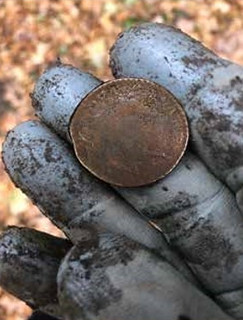 For American Colonial numismatic items
recovered in North America between
August 1, 2022 and August 1, 2023.
Cash prizes and more!
Open to everyone – members and non-members
For complete details, visit
colonialcoins.org/C4competition2023
For American Colonial numismatic items
recovered in North America between
August 1, 2022 and August 1, 2023.
Cash prizes and more!
Open to everyone – members and non-members
For complete details, visit
colonialcoins.org/C4competition2023
RULES, REGULATIONS, INFORMATION & PICTURE SUBMISSION:
- A free entry contest open to everyone, C4 members and non-members as well.
- Only North American found colonial numismatic items acceptable. These include coin, artifact or hoard.
- Competition timeline from August 1, 2022 to August 1, 2023.
- All contestants must submit photos of the obverse and reverse along with date, county and state recovered.
- Please send submissions to each of the 2 email addresses: Region1VP@colonialcoins.org and Region7VP@colonialcoins.org
- No limit to number of submissions entered for the 2022/2023 competition.
- Preference to competitors who also produce a photo or video of their find in situ.
- If item is cleaned, a pre and post photo is recommended.
- The winning finds will be determined solely within the discretion of the C4 metal detecting committee.
- The committee will meet and determine the winners in time for it to be announced at our 2023 C4 convention in Baltimore. Winners do not need to be present to win.
- Grand Prize: $150.00
- First Runner Up: Prize: $100.00
- Second Runner Up Prize: $50.00
- 4th thru 6th place contestants receive a book authored by Will Nipper titled In Yankee Doodle's Pocket: The Myth, Magic & Politics Of Money In Early America.
- All images and information submitted become the property of C4 and may be used by C4 for publicity or research purposes.
VOCABULARY TERM: MONEYER
Here's another entry from Dick Johnson's Encyclopedia of Coin and Medal Terminology. -Editor
Moneyer. An early coiner; a person who made coins before minting plants were established, during the Industrial Revolution. Moneyers were granted authority by a king or some municipal official to strike coins for a specified area. Their pay was typically one coin for every twelve produced, called brassage. Moneyers faced two problems: a supply of blanks –sometimes cast or cut from beaten plates of metal (see blanking) – and engraving the dies for the moneyer to strike (see dies and diemaking). They would strike coins between the dies with a heavy blow from a hammer, one die secured in an anvil, the other held by the coiner. In numismatics this is known as hammered coinage. As technology advanced, the manufacture of coins moved from the workroom of a moneyer to a building specifically intended for the production of coins, a mint, and from a moneyer with an assistant or two, to craftsmen with specialized tasks (see mints and minting).
History of moneyers. The first moneyers were created in Rome, 104 to 89 bc, according to numismatic writer Theodore Mommsen. Three officials were named to a triumvirate vested with the authority to oversee striking the coins by the moneyers. The monetarii were the mint engravers.
The decline of the moneyers did not come to a quick end. They fought the introduction of the screw press whenever it was used to strike coins. In England it was introduced in 1561 for 12 years, overthrown by the moneyers, until 1662 when the screw press was finally accepted. The same thing happened in France, until 1641 when the moneyers were finally replaced there.
References:
E3 {1902-30} Forrer. See Mint-Masters 4:88 and 8:61.
To read the complete entry on the Newman Numismatic Portal, see:
Moneyer
(https://nnp.wustl.edu/library/dictionarydetail/516353)
DALE ESTIN BIRDSELL (1920-1998)
E-Sylum Feature Writer and American Numismatic Biographies author Pete Smith submitted this article on KKK token book author Dale Birdsell. Quite interesting - thanks! -Editor
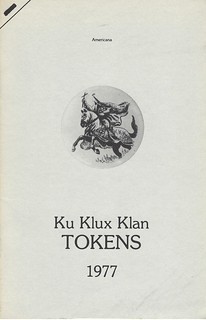 Recently I wrote about one of my favorite numismatic heroes, Charles McCormick Reeve. This
week I take up one of my favorite numismatic villains, Dale Birdsell. I will relate two versions of
his story that are as different as black and white.
Recently I wrote about one of my favorite numismatic heroes, Charles McCormick Reeve. This
week I take up one of my favorite numismatic villains, Dale Birdsell. I will relate two versions of
his story that are as different as black and white.
Dale Estin Birdsell was born on June 4, 1920, in Hillsboro, Oregon. His father was Curtis John Birdsell (1876-1942). In the 1930 Census, he was listed as a real estate agent. In 1940 as the county assessor. Dale's mother was Elizabeth Manning Simon (1893- ).
Birdsell was discharged from the Army in 1941 for swindling. He enlisted in the Army again on July 24, 1943 and served overseas during World War II. His registration papers indicate he had two years of college and was employed as an office clerk. He was listed as single with dependents. He was examined by an Army psychiatrist in 1944 who found him to be psychopathic and he was discharged.
In the 1950 Census, he was in Providence, Rhode Island, (Home of Brown University) listed as a history teacher living with his wife, Myrtle Birdsell, a college librarian.
In August of 1956 he was selected as a judge to pick the winner for the Miss Mississippi contest. He was described as director of the American Models Association in New Orleans.
A month later he was charged with extortion. Birdsell, working with the College Queen contest, took nude pictures and threatened to expose and disgrace one of the women. At the time he was editor and publisher of Southern Digest, a pro-segregation paper in Baton Rouge. A search of his house turned up a hypodermic needle and syringe. Possession resulted in a seven year prison sentence at Angola State Penitentiary. In June of 1957 he was granted a new trial because of faults with the first trial. The Mississippi Supreme Court declared the conviction unconstitutional and he was released.
Just a few months later in 1958, Birdsell, 37, met a 16-year-old girl in the Ritz Hotel lobby in Washington. She had run away from home in Maryland. He said she could be a model and offered to manage her career. They got on a bus intending to go to New Orleans. They got as far as Memphis where the girl became disillusioned with Birdsell. She left him and notified police. He and the girl were registered at the King Cotton hotel as husband and wife. Birdsell was tried and convicted of contributing to the delinquency of a minor, fined $1000 and sentenced to 11 months and 29 days in the Selby County (Tennessee) workhouse.
In 1960, he was described as an Arkansas Ku Klux Klan organizer. On trial again, he could not afford an attorney and represented himself. He gave a long speech in his defense saying that he had an irresistible impulse due to a mental and emotional breakdown. He said that he had two unsuccessful marriages, a psychiatric discharge from the army and suffered a skull fracture in an automobile accident, He was convicted of five counts of passing bad checks and again received a two-year prison sentence. He was released on probation in May of 1962.
In 1964, Birdsall was convicted on charges related to transporting three Thunderbirds for sale in Mexico. An attempt was made to determine his sanity. He testified to doctors that he was acting under orders from his commanding general, Nathan Bedford Forrest, provisional Army Confederate States of America and Imperial Wizard of the Ku Klux Klan. He said that stealing cars was not illegal as he was foraging to support the cause. The doctor concluded that Birdsall could no longer tell right from wrong and should be committed to a federal mental institution. He was admitted to Springfield, Missouri Medical Center for Federal Prisoners. The conviction was sustained.
In 1969 he was charged with forgery, declared incompetent to stand trial and was sent to Austin State Hospital where he escaped.
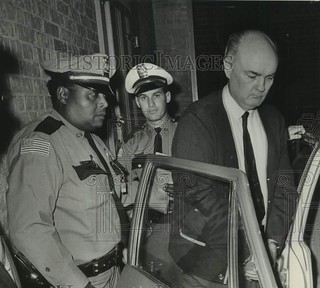 In Houston in 1970, he admitted that he cashed 200 bad checks worth $10,000. He claimed that
he was raising money to finance a rightwing revolution. He intended to pay everyone back after
the revolution.
In Houston in 1970, he admitted that he cashed 200 bad checks worth $10,000. He claimed that
he was raising money to finance a rightwing revolution. He intended to pay everyone back after
the revolution.
The numismatic community is fortunate that Birdsell was out of prison long enough to make his contribution to numismatic literature. Birdsell compiled Ku Klux Klan Tokens that was published in 1977. It was twenty pages with illustrations describing eighty pieces. A second edition published in 1981 was expanded to forty pages.
In 1984 he was again arrested in Victoria, Texas, and accused of passing bad cashier's checks worth $17,367.91. He was implicated in a larger nation-wide check forging scheme.
Dale died on April 8, 1998, in Fairfax, Virginia. His service entitled him to burial at Quantico National Cemetery in Virginia. Dale Birdsell and Myrtle Birdsell are buried in the same plot. The Findagrave listing has no family relationships mentioned for either of them.
The second story was published by Reed College in Portland, Oregon, after his death.
Dale Birdsell '48, April 8, 1998, in Fairfax, Virginia. He first entered Reed in 1941, but left
during World War II to serve in the Army overseas. After the war, he returned to Portland,
worked for Southern Pacific Railroad, and completed his undergraduate degree at Reed in
1948. He then attended Brown University, earning a master's in history in 1950. He worked
on a PhD in history at the University of Pennsylvania and had completed all but his
dissertation when he left to work as a historian in the U.S. Army Chemical Corps Historical
Office in Edgewood, Maryland. There, he coauthored a volume of the series, The U.S. Army
in World War II, The Chemical Warfare Service: Chemicals in Combat, which also served
as his PhD dissertation.
He remained in that position until 1967 and authored or coauthored many official studies, histories, and reports. In 1967, he was promoted to chief historian of the U.S. Army Materiel Command, and he and his wife and children relocated to McLean, Virginia. He became director of historical programs and author of a variety of official special studies and reports. He also directed, edited, and coauthored a publicly published volume, Arsenal for the Brave: A History of the U.S. Army Materiel Command. He retired in 1986. In retirement, he pursued a variety of interests and community activities and was involved in a weekly current events group at the retirement community where he lived. He is survived by his wife and two sons.
There is just enough overlap to confirm the two stories are about the same person.
Throughout my research, I was plagued with conflicts finding records for Dale Estin Birdsell, born in Oregon on June 4, 1920, and Dale Estine Birdsell born in Texas on November 5, 1921.
Dale E. Birdsell joined the American Numismatic Association in 1981 as member R-113805. He gave his address as a P. O. Box in Grand Bay, Alabama. The KKK book was published in Grand Bay, Alabama. There is a public record giving the birthdate of Birdsell in Grand Bay as November 5. 1921, the birthdate for the Texas Birdsell.
The Oregon Birdsell had a history of using an alias and of obtaining identification cards for real people that were not him. I wonder if Oregon Birdsell was using Texas Birdsell's identification when he joined the ANA. Was this a records error or intentional deception?
Inconsistencies in the stories remain that I can't resolve.
Wow - that was eye-opening. Many thanks to Pete for bringing this history to light. I believe the bad checks were first mentioned by Rich Hartzog in 2017.
The back cover of both books advertises the planned publication of a pictorial history of the Klan, that apparently was never published. -Editor
To read the earlier E-Sylum articles, see:
KU KLUX KLAN TOKEN BOOK, 2ND EDITION
(https://www.coinbooks.org/v20/esylum_v20n26a31.html)
CHARLES MCCORMICK REEVE
(https://www.coinbooks.org/v26/esylum_v26n18a21.html)
NOTES FROM E-SYLUM READERS: APRIL 30, 2023 : KKK Token Book Printing Confirmed
(https://www.coinbooks.org/v26/esylum_v26n18a16.html)
THE ORIGINAL AND SECOND MR. RED BOOK
An article by Joel Orosz on Coin Update excerpted from Kenneth Bressett's memoir A Penny Saved: R.S. Yeoman and His Remarkable Red Book looks at Bressett and mentor, hobby legend Richard S. Yeo (known as R.S. Yeoman). With permission, we're republishing portions here. For more, see the book or the complete article linked below. -Editor
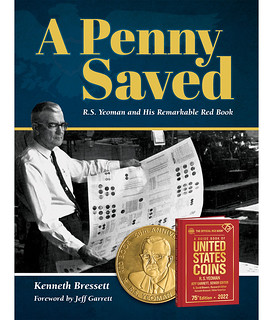 Two Whitman book series, the Handbook of United States Coins and A Guide Book of United States Coins, both truly numismatic institutions, were the inspiration and dedication of two men, who first established, then refined these series for decades. One, Richard Yeo, was the founder, consummate salesman, and ambassador; the other, Kenneth Bressett, was the scholar and developer. The story of their joint achievement, annually renewed, is worthy of note and remembrance.
Two Whitman book series, the Handbook of United States Coins and A Guide Book of United States Coins, both truly numismatic institutions, were the inspiration and dedication of two men, who first established, then refined these series for decades. One, Richard Yeo, was the founder, consummate salesman, and ambassador; the other, Kenneth Bressett, was the scholar and developer. The story of their joint achievement, annually renewed, is worthy of note and remembrance.
Richard Yeo was a son of the Badger State, blessed with a flair for design and a knack for making friends. Whitman Publishing of Racine, Wisconsin, hired Yeo in 1932 and soon put him to work selling coin boards and, later, the celebrated blue coin folders beloved by generations of young collectors. Although new to numismatics initially, he wasn't afraid to ask specialists for guidance.
As R.S. Yeoman, Yeo continued as editor of the Red Book for nearly a quarter century, making it into the most trusted guide for retail prices and earning him the title Mr. Red Book.
Throughout the 1960s, he frequently appeared as a brand ambassador for his many publications at coin shows, conventions, and clubs, where he autographed books and charmed collectors with his modest demeanor and engaging personality. By the time of his retirement in 1970, he had proven his pen name truly apt, for his yeoman's service
benefitted not only Whitman Publishing, but all of numismatics.
Of all of Yeoman's many achievements, perhaps the greatest was mentoring his successor.
Ken Bressett of Keene, New Hampshire, became a numismatist while in his teens. He had printer's ink in his veins, as one of his early jobs was as a printer's devil
in the twilight years of the hot-lead printing process. In the mid-1950s, Yeoman was attending a coin show, and Bressett discussed with him some questionable items in the Guide Book. Instead of taking offense, Yeoman recognized his talent and later engaged him as a freelance editor. Whitman hired Bressett in 1959, with his responsibilities encompassing the Blue Book and Red Book series. By 1962 he was made assistant editor and later managing editor in 1965, giving Yeoman more opportunities to be a roving ambassador.
Bressett's tenure as editor lasted an astonishing 53 years; even after his formal retirement in 2018, he has continued with special projects for Whitman. It was natural, therefore, that following Yeoman's death in 1988, Bressett inherited the title of Mr. Red Book.
Bressett's stewardship was lengthy, and also quietly revolutionary. He enhanced not just two book series but an extraordinarily successful and truly beloved numismatic institution. A glance at the 1966- and 2019-dated editions of both the Red Book and the Blue Book shows how vastly he (often with some behind-the-scenes help from his son, Philip) improved these iconic products. They employ similar organizational schemes, but everything from the typeface to the factual content was enriched. Page counts nearly doubled, incorporating new coin issues, and novel research expunged old errors and added important fresh findings. Timely special features were added.
Ken Bressett achieved the highly improbable: he supervised the production of two successful books and, for five decades, simultaneously preserved and reinvented them—a seamless fusion of tradition and transformation.
Two men, two enduring book series, more than three-quarters of a century; one shared sobriquet. Only the oldest coin collectors of 2023 can remember numismatics without the Blue Book or the Red Book, all thanks to the extraordinary exertions of not one Mr. Red Book
but two.
To read the complete article, see:
The original and the second Mr. Red Book
(https://news.coinupdate.com/the-original-and-the-second-mr-red-book/)
To read the earlier E-Sylum article, see:
NEW BOOK: A PENNY SAVED
(https://www.coinbooks.org/v24/esylum_v24n16a02.html)
ANS CHAIRMAN'S FELLOWSHIP FOR NUMISMATIC RESEARCH
The ANS has created a new fellowship for numismatic research. Here's the press release announcing the first recipient. Congratulations. -Editor
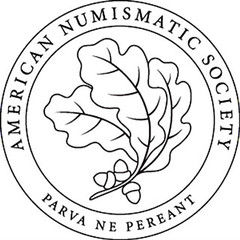 The American Numismatic Society (ANS) is pleased to announce that Melissa
Ludke has been selected as the inaugural recipient for the Chairman's
Fellowship for Numismatic Research. The fellowship will go toward funding her
dissertation research and planned book project:
The American Numismatic Society (ANS) is pleased to announce that Melissa
Ludke has been selected as the inaugural recipient for the Chairman's
Fellowship for Numismatic Research. The fellowship will go toward funding her
dissertation research and planned book project: Cosa and Socio-Economic
Interactions among Middle Republican Cities in Central and South Etruria.
Ludke is a doctoral candidate in Classical Archaeology at Florida State University, where she earned her MA in Classical Archaeology; she received her BA in Anthropology from Grand Valley State University. Ludke has worked on the Cosa excavations in Ansedonia, Italy since 2016, and the Excavation Coins Inventory Project with the Soprintendenza Archeologica della Toscana since 2022. Her dissertation will investigate the interactions between Cosa and neighboring cities in the third century BCE by reexamining materials from the site, including coin assemblages of regional, foreign, and Roman origin, to determine overlapping circulation patterns and how those inform an interpretation of those relationships. Ludke will present her research at a future Long Table lecture, hosted by the ANS and open to members of the Society.
The ANS awards a limited number of Chairman's Fellowships each year, worth between $1,500 and $2,500 each, to qualified graduate students or scholars pursuing serious numismatic research projects that are expected to result in academic publication. More information about the fellowship and applying can be found at numismatics.org/chairmans-fellowships-for-numismatic-research/.
EARLY AMERICAN HISTORY AUCTION MAY 23, 2023
Here's the announcement for the May, 2023 sale by Early American History Auctions. -Editor
Early American History Auctions is proud to announce its outstanding upcoming May 27th, 2023 Saturday of
the Memorial Day Weekend American Patriot
Auction focusing on the Historical Collections of Ambassador
J. William Middendorf II
This exceptional auction of 264 lots will feature many highly important Early American Historical Prints, Paintings, Autographs, Documents and Americana, many consigned from the Collection of Ambassador J. William Middendorf II, one of America's foremost historical collectors, specializing in American Military history from Colonial though Revolutionary War and beyond, recording various Naval Engagements and important Commanders. This auction contains numerous highlights from the Middendorf collection, including our featured Highlight:
1770 (Sons of Liberty Founding Member) Paul Revere's
Original Hand-Colored Copper-Plate Engraving of The
Bloody Boston Massacre.
The Most Famous and Historic
Engraved Print in American History, its propaganda helping
to ultimately bring forth the American Revolutionary War. Its
image reproduced in virtually every American History Book,
and one of only 29 Copies Known.
Other highlights include:
c. 1775 Militia Officers' Waistcoat Patriot Spy / Courier / Emissary Dr. Samuel Nicoll of New York, Identified
in a 1778 Letter Sent to General George Washington from Revolutionary War New York Spymaster
Major
Benjamin Tallmadge, Dr. Nicoll's Militia Officers' Waistcoat, Ex: King's College / Columbia University Display
Housed Since its 1929 Donation and subsequent Deaccession.
Historic 1774 Engraved Print titled, The Bostonians in Distress
London, printed for R. Sayer & J.Bennett,
Map & Printsellers.
c. 1774 Engraved Print titled, LIBERTY TRIUMPHANT: or the Downfall of OPPRESSION.
with Lead us
to Liberty or death!
and We will secure our freedom, or die in the Attempt.
This Historic Satirical Cartoon
Engraved Print & Map was published shortly after the Boston Tea Party
by Philadelphia & New York
engraver Henry Dawkins.
Impressive 1779-Dated, JOHN PAUL JONES, Commander of a Squadron in the Service of the Thirteen
United States of North America, 1779.
Revolutionary War Mezzotint Engraving.
1781 Capt John Paul Jones
Fully Identified Hand-Painted and Dated Silhouette of Jones Wearing His
Revolutionary War Naval Officer's Uniform, a.k.a. the Father of the American Navy
.
Original Watercolor Miniature Portrait of Captain John Paul Jones, Attributed to Artist Sarah Goodrich (1783- 1853).
President George Washington Oil Painting on Canvas, after Gilbert Stuart's original Lansdowne Portrait
Painting.
Numerous Other Important May 27th Auction Lots Include:
Thomas Abernethie's Own Personal Autographed Book titled, The History of the Revolution of South
Carolina...
with His Historic Engraved Fold-out Map of Charleston Harbor Contained Within, Engraved by
Thomas Abernethie, Colonial South Carolina's Paper Money and Map Engraver;
Daniel Boone & Rebecca Boone Signed Land Sale Deed, with Daniel and his Wife
also being Named Ten
Separate Times;
1792 AARON BURR Autograph Letter Signed, with Integral and FREE
Franking Signature A Burr
Transmittal Leaf;
an 1865 13th Amendment Printed Broadside, Freeing Slaves, Previously Unlisted & Apparently A Unique New Discovery;
1859 Declaration Independence Plaque by Samuel H. Black, an Extremely Rare Large and First Seen,
Likely Unique, Major Variant Negative Plate
Production Process Type, plus the resulting 1859 Declaration
Independence Plaque by Samuel H. Black, a Large Major Variant Type;
1780 Benjamin Edes Signed, Extremely Rare Revolutionary War Boston
Town - Treasury Interest Bearing
Tax Loan Certificate: for the Purpose of carrying on the War.
Signed by David Jeffries
Deacon of Old South
Church as Town Treasurer, an Unknown Fiscal Form, Not Listed in Anderson;
1744 Benjamin Franklin Printed Book of Cicero's Cato Major, or his discourse of Old-Age: with Explanatory
Notes
;
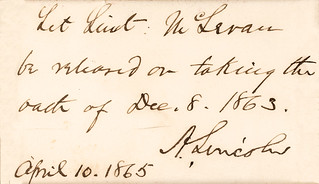 APRIL 10, 1865 Dated Historic Manuscript Note Signed
APRIL 10, 1865 Dated Historic Manuscript Note Signed A. Lincoln
as President, Signed Just Four Days
Prior to Lincoln's Assassination by John Wilkes Booth at Ford's Theater;
America
by Samuel Francis Smith Signed and Dated, First Four Stanzas of American Patriotic Song My
Country ‘Tis of Thee
;
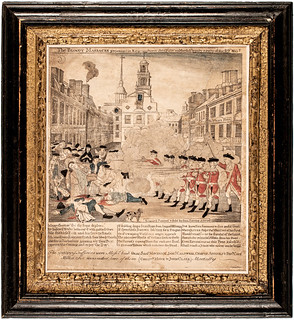 Paul Revere's Historic Engraved Print of the British Troops Landing at Boston Harbor per the British
Paul Revere's Historic Engraved Print of the British Troops Landing at Boston Harbor per the British
Intolerable Acts
titled, A Prospective View of the Town of BOSTON, the Capitol of New England ;
and of the Landing of ---- Troops in the Year 1768, in Consequence of Letters from Gov. Bernard, the
Commissioners, & c. to the British Ministry. - EDES & GILL's North - American ALMANACK For the Year
1770
;
Exceedingly Rare Colonial Currency Note dated August 21, 1775, North Carolina, Four Dollars Hillsborough
Issue, PCGS Extremely Fine-40;
Rare February 1781 VERMONT CALLS FOR JUSTICE
One Shilling & Three Pence Colonial Note, PMG
Choice Fine-15;
1777 FRANCIS HOPKINSON & JOHN NIXON Signed Partly-Printed Continental Navy-Board Issued Document;
Cambridge, Mass. Newspaper reporting on the Olive Branch Petition
and General Thomas Gage's Official
Report on the Battles of Lexington & Concord, Front Page;
Continental Congress Prize Agent at Boston, John Bradford, writes a Letter to Continental Congress President
John Hancock Complaining about one of the Captains in George Washington's American Armed Privateer Ships
Little Navy
;
Collection of Nine different rare (1789) George Washington Inaugural Buttons;
Important Freedom of the Press
and First Amendment
Historic Landmark 1803 Libel Case, Thomas
Jefferson v Alex. Hamilton;
1836 Texas Revolt Mexican Broadsheet Decree Commuting the Death Penalty of Certain Texan Prisoners of War Passed after Victory at the Alamo, by Secretaria de Guerra y Marina;
Rare 1828 Presidential Campaign Broadside of An account of some of the Bloody Deeds of GENERAL
JACKSON.
With Historic Woodcut Illustrations;
(14) Different 1862 Encased Postage Stamps being the Emergency Small Change Currency of the Civil War Era;
17th to 18th Century, Rare and Important Early S
Head Branding Iron for Slaves;
1808 Published Illustration Plan and Sections of a Slave Ship as Published by J. P. Parke, Copper-Plate Engraved by Kneass, Philadelphia;
c. 1800 Charles Balthazar Julien Feveret de Saint-Memin Original Pastel Profile Portrait Artwork and Decoratively Framed;
Very Rare Restored Revolutionary War Period British Military 2nd Model Short Land 1779 Pattern Brown
Bess
maker engraved, HENSHAW
and branded on the left side of comb CUMBERLAND
with Roman
numerals X I X
;
an Important 1799 to 1804 Cased Pair of English Flintlock Dueling Pistols by GULLEY, LONDON;
c. 1761 Extremely Rare Original Colonial Boston Harbor Engraving titled A View of the City of Boston the
Capital of NEW ENGLAND, in North America.
After Gov. Pownal;
Colonial American Coins & Medals Include:
Undated (c. 1694) London Elephant Token. Hodder 2-B, W-12040.
GOD PRESERVE LONDON
Legend. Thick Planchet. PCGS graded Mint State-62 Brown;
Undated (c. 1793-1795) Kentucky Token. W-8815. Rarity-8+. Copper. Unique. PAYABLE AT BEDWORTH
NUNEATON OR HINKLEY
Lettered Edge. PCGS graded About Uncirculated-58.;
(1795) Washington North Wales Halfpenny. Two Stars on Each Side of Harp, Major Variety. Plain Edge. Baker B-1295. Whitman Rarity Rated URS-5 Only 9 to 16 Known, PCGS graded Fine-12.;
1777-Dated (Printed 1776) American Engraved Revolutionary War Printed Map titled, A VIEW of the Present
Seat of WAR, at and near NEW-YORK.
from the 1777 An Astronomical Diary; Or Almanack.
by Nathaniel
Low, as Printed by J. Gill, Boston, MA.;
and much more!
All May 27th auction Lots are currently available to view and place Absentee Bids Online at:
www.EarlyAmerican.com. This Online
auction catalog includes extensive additional related historical
information and many more images, than provided in the published catalog. Therefore, it is highly
recommended to view these important items Online. Being held on Saturday of the Memorial Day weekend,
please place your bids in advance of your holiday activities. Please request any additional information well in
advance of the auction date. Phone Early American History Auctions with any questions or for special financial
arrangements. We welcome our collector community to enjoy and participate in this remarkable May 27th
auction.
PHG SWISS SHOOTING MEDALS SELECTIONS
Stack's Bowers Senior Numismatist and Cataloger Jeremy Bostwick published an article on Swiss Shooting Medals, featuring the PHG Collection offered in the firm's upcoming May Collectors Choice Online Auction. Here's the article and some lot images that caught my eye. -Editor
Among the countless highlights in our upcoming May Collectors Choice Online (CCO) auction, a four-day event running from May 16th -19th , we are happy to present a rather extensive collection of artistic award medals from the PHG Collection, the vast majority of which emanate from the increasingly popular series of Swiss shooting medals. While these beautiful and highly alluring miniature works of art offer numerous collecting opportunities, some of the particular standouts include more traditional designs, like lots 73534—issued for the Federal shooting festival held in Geneva in 1887—and 73504—awarded at the Western Switzerland shooting festival held in Biel in 1893.
Others utilize timeless motifs and iconography, with Neoclassicism serving as a popular inspiration for engravers, such as lots 73531—presented for Geneva's Society of Riflemen in 1882—and lot 73611—struck for the Federal shooting festival held in Frauenfeld in 1890.
Still others parallel the changing art movements of the late 19th and early 20th centuries, employing hints of Art Nouveau on lot 73475—issued for the Aargau Cantonal shooting festival in 1902—and featuring strong nods to Art Deco on lot 73559—awarded at the Sempach annual shooting festival from the 1920s. These festival-centric issues weren't limited to medallic form, however, as coins at times also commemorated the events, with the crown module offering a great analog to the award medals.
An early
example of a shooting Taler
is lot 73547—a 4 Francs from 1842 celebrating the Federal
Free Shoot in Chur. No matter one's specific collecting focus or interests, the PHG Collection
likely offers a number of treasures for collectors both advanced and novice.
Great medals. These remind me of my old friend and mentor Charles N. Erb of the Western Pennsylvania Numismatic Society. Of Swiss ancestry, Chuck was known primarily for collecting Bust Halves by die variety, but he also made a specialty of Swiss Shooting Talers, and spoke about them at WPNS more than once. -Editor
To view lots in the sale, see:
May 2023 World Collectors Choice Online Auction - Ancients, Latin America & World Coins Part 1 - Lots 71001- 71765
(https://auctions.stacksbowers.com/lots?sort=auction_date_lot_number_asc
&search=From+the+PHG+Collection&limit=96&lots_range=upcoming)
STEPHEN ALBUM RARE COINS AUCTION 46
Here's the press release for Stephen Album Rare Coins upcoming Auction 46. -Editor
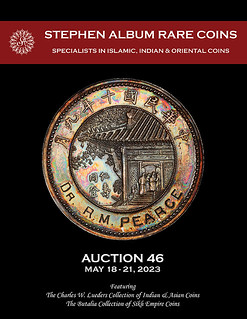 Stephen Album Rare Coins will hold its Auction 46 on May 18-21, 2023 at their new offices in Santa
Rosa, California. The auction is made up of 2800 lots of Ancient, Islamic, Indian, Chinese, and World
Coins. The first two days offer floor bidding in addition to internet bidding, while the third and fourth
days will be internet-only sessions. Featured in this auction will be the Charles W. Lueders Collection of
Indian & Asian Coins and the Butalia Collection of Sikh Empire Coins.
Stephen Album Rare Coins will hold its Auction 46 on May 18-21, 2023 at their new offices in Santa
Rosa, California. The auction is made up of 2800 lots of Ancient, Islamic, Indian, Chinese, and World
Coins. The first two days offer floor bidding in addition to internet bidding, while the third and fourth
days will be internet-only sessions. Featured in this auction will be the Charles W. Lueders Collection of
Indian & Asian Coins and the Butalia Collection of Sikh Empire Coins.
The coin featured on the cover of the printed catalog is certain to create a buzz of excitement on the
bidding floor when it comes up for auction. It is a Chinese pavilion
dollar engraved for Dr. R.M. Pearce.
Only a handful of these officially hand-engraved dollars have surfaced, and this is the first piece to be
auctioned with the original award letter from the Office of the President of China!
Some highlights from the sale follow:
LOT 173: ISLAMIC: ARAB-ARMENIAN: Anonymous, ca. 690-700, AR zuzun (3.16g), year "6", A-M97, in the name of the Sasanian king Hormizd IV, with the full Shahada filling the obverse margin after the phrase bism Allah, and with the denomination ZWZWN, Aramaic for "drachm", instead of a mint name on the standard position on the reverse, superb strike for this type, full EF, RRRR.
There are two examples of this type with the full Shahada posted on Zeno, #96964 with the additional phrase "rabbi Allah" added on the reverse margin (sold in M&E Auction 48, Lot 1), and #153562 with "rabbi Allah" instead of ZWZWN at the mint location on the reverse. The full Shahada was introduced to the Arab-Sasanian coinage during the governorship of al-Hajjaj b. Yusuf (694-713), whence it seems likely that this type could not have been introduced before 694, replaced shortly afterwards by the type that replaced the name Hormizd with Muhammad (A-E97) and the Arabic word waf in the obverse margin, introduced circa 700. The prototype was the relatively common Sasanian-Armenian type in the name of Hormizd, usually with year "6" and the phrase ZWZWN in lieu of mint name (e.g., Zeno-17577). Estimated at $17,000 to $19,000.
LOT 786: ISLAMIC: SAFAVID: Tahmasp II, 1722-1732, AR presentation 20 shahi (26.73g), Tabriz, AH1135,
A-A2689, 52.0 mm; obverse couplet translates as "By the grace of God, Tahmasp the Second struck the
sahebqerani coin throughout the world."; an exquisite example, never mounted, choice EF. A similar
specimen sold in Heritage Sale 3021, Lot 21767 (same obverse die).
Estimated at $20,000 to $24,000.
LOT 906: INDIA: MUGHAL: Jahangir, 1605-1628, AV mohur (10.94g), Agra, AH1021 year 7, KM-176.1, month of Shahrewar; obverse imperial legend within ornate cartouche, reverse with mint, date, and month within lobated square; mount removed (visible on the edge, barely noticeable on the surface), but this is a fully preserved beautiful gold mohur! PCGS graded XF details, RRR.
Gold mohurs of a distinctive style were struck only at Agra and only from AH1020-1027, always with a
month included on the reverse. The mohurs included obverse & reverse borders that were redesigned
every month, with 12 different arrangements issued every year. The great rarity of these mohurs is
intensified by the fact that each style would last only one month. For AH1021, the British Museum
catalog lists only the months of Di and Mehr, and on CoinArchives appear the months of Farwardin and
Khurdad. This piece would be the fifth month we have noted, though it is likely that AH1021 mohurs of
every month were struck.
Estimated at $20,000 to $25,000.
LOT 964: INDIA: MYSORE: Tipu Sultan, 1782-1799, AV mohur (10.98g), Patan, AH1197 year one (ahad),
KM-B129, well-centered, wonderful strike, a choice example of this rare issue, EF-AU, RRR, ex Charles W.
Lueders Collection.
Gold coins of this type were first struck in AH1197-1200 at the weight of the standard Mughal mohur
(about 11.00g). They were then replaced by a larger denomination called four pagodas, dated AM1216-
1219, at a weight standard of about 13.75g, equal to four times the weight of the standard Mysore gold
pagoda of about 3.43g.
Estimated at $14,000 to $17,000.
LOT 1105: CHINA: REPUBLIC: AR dollar, year 10 (1921), Kann-676a, L&M-957, Hsu Shih-chang 'Pavilion' type, plain edge without bottom legend variety, hand-engraved DR. R. M. PEARCE on reverse, a lovely toned example and with accompanying original case and letter from the Office of the President of China! PCGS graded SP Genuine / UNC details (for the engraving).
The Xu Shichang Dollar (Pavilion Dollar) is one of the most sought-after coins in Chinese numismatics. Dated Month 9 of Year 10 (1921), it depicts President Xu in a decorated Western-style suit jacket and a presidential sash. On the reverse, four figures in traditional Chinese robes greet one another on the steps of a pavilion, alongside the phrase ren shou tong deng ("Virtue and longevity ascend together"). Of all the varieties in silver, the plain-edge type with a hand-engraved name at the reverse bottom is by far the rarest, as this is only the 10th example to appear in a public auction since its first appearance in 1982. It is followed by the unengraved plain-edge type (K-676a), the unengraved reeded-edge type (K-676b), and, most commonly, the reeded-edge type with the legend ji nian bi ("commemorative coin", K-676).
The purpose behind the Pavilion Dollar is not entirely clear. Some writers have suggested it celebrates both President Xu's 66th birthday and 3rd anniversary in office (both occurring in October, which is the 9th month in the Chinese calendar). Others argue it was struck for the opening of the Peking Union Medical College (PUMC, beijing xiehe yixueyuan). Founded in 1906 by a group of British and American missionary organizations, the college sought to introduce Western medical education to China at a time when modern healthcare was practically non-existent in a nation of more than 400 million. It received generous support from the Rockefeller Foundation, which spent $8 million to construct a brand-new campus in the middle of Beijing. The dedication ceremony and the concurrent medical conference took place on Sept. 15-21, 1921. It was attended by a delegation led by John D. Rockefeller, Jr. himself. Also in attendance were many staff members of the college, government officials, as well as doctors from around China and the world.
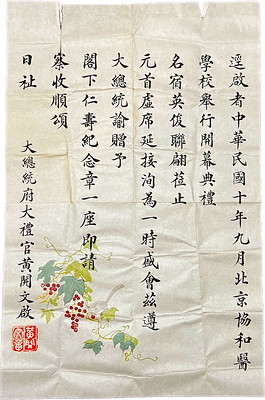 To commemorate this event, the office of the President gave out this medal (K-676a) to the attendees,
as attested by the accompanying letter. This likely took place at the dedication ceremonies on the
afternoon of Sept. 19, when cabinet ministers delivered greetings on behalf of the President. Based on
contemporary reports, we know that the people whose names appear on the medal were doctors (e.g.
Dr. R. G. Mills) and staff (Miss Helen H. Holland) at PUMC, as well as visiting delegates (Mr. E. R. Embree)
and conference attendees (Dr. J. A. Bussière). We can also surmise that many attendees received the
medal but did not engrave their name on it (e.g. Dr. Andrew H. Woods), judging from the greater
number of unengraved examples. This is perhaps because the engraver(s) at the event did not have
enough time and only served some of the recipients, as suggested by the diverse positions of the names.
To commemorate this event, the office of the President gave out this medal (K-676a) to the attendees,
as attested by the accompanying letter. This likely took place at the dedication ceremonies on the
afternoon of Sept. 19, when cabinet ministers delivered greetings on behalf of the President. Based on
contemporary reports, we know that the people whose names appear on the medal were doctors (e.g.
Dr. R. G. Mills) and staff (Miss Helen H. Holland) at PUMC, as well as visiting delegates (Mr. E. R. Embree)
and conference attendees (Dr. J. A. Bussière). We can also surmise that many attendees received the
medal but did not engrave their name on it (e.g. Dr. Andrew H. Woods), judging from the greater
number of unengraved examples. This is perhaps because the engraver(s) at the event did not have
enough time and only served some of the recipients, as suggested by the diverse positions of the names.
Born in Montreal, Canada, Dr. Richard M. Pearce (1874-1930) was a prominent professor of pathology
based in New York City. From 1919 to his death, he was the Director of the Division of Medical Education
of the Rockefeller Foundation. It was in that capacity that Dr. Pearce visited PUMC as a member of the
delegation and received this medal. To our knowledge, his is the only example among the ten Pavilion
Dollars to be certified uncirculated (PCGS #46508883, graded details solely due to the engraved name)
and accompanied by the original case and letter. It is likely the finest example of this highly coveted type
and a testament to the deep roots of US-China relations.
Estimated at $75,000 to $100,000.
LOT 1133: CHINA: HUNAN: Kuang Hsu, 1875-1908, AE 10 cash, ND (1902), KM-Pn5, CL-HUN.98, CCC-193,
Duan-702, copper pattern issue by the Heaton Mint, three characters at bottom, without dot between
Manchu words, lustrous surfaces with vibrant notes of purple and orange, the single finest example at
PCGS and a fantastic example of this rare issue! PCGS graded Specimen 64 BN, RR.
This pattern was produced in 1902 at the Heaton Mint in Birmingham for a proposed brass coinage that
was ultimately not adopted. The dies were then recut from the three characters (huáng tóng yuán,
"brass yuan") to two (tóng yuán, "copper yuan") and struck in copper for circulation (Y-112.12).
Estimated at $35,000 to $40,000
LOT 1282: WORLD: IRAQ: Faisal I, 1921-1933, 12-coin double proof set, 1931//AH1349, a very rare double presentation proof set struck at the British Royal Mint, consisting of two each of the 1, 2, 4, 10, 20 and 50 fils coins, all graded by NGC:
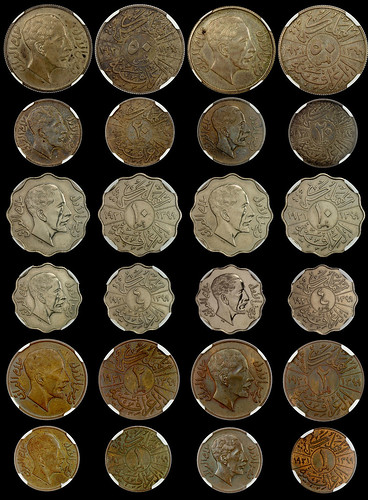 1 fils PF-62 BN, PF63 BN copper
1 fils PF-62 BN, PF63 BN copper
2 fils PF-63 BN, PF-61 BN copper
4 fils PF-61, PF-61 copper-nickel
10 fils PF-63, PF-65 copper-nickel
20 fils PF-62, PF-61 silver
50 fils PF-62, PF-64 silver
with original British Royal Mint presentation maroon case of issue, engraved in gilt lettering IRAQ
CURRENCY BOARD atop with ornate gilt borders, a very rare and desirable item! set of 12 coins, RR.
Estimated at $40,000 to $60,000.
LOT 1460: WORLD: NETHERLANDS: UTRECHT: NETHERLANDS: UTRECHT: United Netherlands, AR 2
ducaton (65.03g), 1776, KM-P67, Dav-1831, Delmonte-1031a, double thickness (piéfort) presentation
strike of the silver rider ducaton, attractive deep patina, very rare, NGC graded MS61, R2 (Delmonte), ex
Irving Goodman Collection (Goldberg Sale 15, June 2002, lot 874).
Estimated at $ 7,500 to $9,500.
The firm's CEO Joseph Lang notes: We have been inundated with material for our auctions both before
and after our move to our new offices. We are proud of the high-quality sale that we have put together
for May, and we are already preparing for a similarly robust floor sale in September
.
The firm is currently accepting consignments for its Auction 47, which will take place on September 14- 17, 2023, as well as future internet-only sales. Please see www.stevealbum.com for more information.
NUMISMATIC NUGGETS: MAY 14, 2023
Here's a selection of interesting or unusual items I came across in the marketplace this week. Tell us what you think of some of these. -Editor
1799 New York Associate Church Communion Token
New York--New York. 1799 Associate Church Communion Token. Lead or Pewter, Cast. Plain Edge. Very Fine.
23.5 mm x 17.5 mm, oval. Obv: Inscription ASSOCIATE / CHURCH within plain border. Rev: Inscription N. YORK with date 1799 below. Dominant pewter-gray coloration with a few splashes of deeper steel-russet on the obverse. A casting flaw at 12 o'clock on the reverse is as made, as is another shallower flaw in the left field on that side. An appealing token and quite rare.
Indeed, quite rare. From the June 2023 Stack's Bowers Numismatic Americana sale. -Editor
To read the complete lot description, see:
New York--New York. 1799 Associate Church Communion Token. Lead or Pewter, Cast. Plain Edge. Very Fine.
(https://auctions.stacksbowers.com/lots/view/3-13799T/new-york-new-york-1799-associate-church-communion-token-lead-or-pewter-cast-plain-edge-very-fine)
Anti-Hitler Piggy Bank
WWII Anti-Hitler Propaganda Piggy Bank
"Save for Victory. Make Him Squeal"; c. 1942; Paper Mache; 5" x 5" x 7"; Note: no bottom
Cool item. I'd never seen one of these before. Interesting. -Editor
To read the complete lot description, see:
WWII Anti-Hitler Propaganda Piggy Bank
(https://www.barnebys.com/auctions/lot/wwii-anti-hitler-propaganda-piggy-bank-aWXxIqHBI3Q)
1978 New York Medal
I was unfamiliar with this medal in the offerings of Hedley Betts. Great obverse, although I don't understand what the reverse is trying to represent - it looks like a highway interchange, but overlaid over buildings. A statement on automobile culture, perhaps? I found the linked article with a little more information on Thérèse Dufresne. -Editor
To read the complete article, see:
Thérèse DUFRESNE artist sculptor medalist (1937-2010)
(https://en.nicolas-salagnac.com/therese-dufresne-artist-sculptor-medalist-1937-2010/)
To read the complete lot description, see:
1978 U.S.A. NEW YORK by Therese Dusfresne 81mm
(https://www.ebay.com/itm/166081399876)
ENGRAVED STONES FOUND IN ROMAN BATHHOUSE
Paul Horner writes:
"Not exactly coins, but these Roman intaglios found in England are still pretty and interesting."
Indeed - very nice work. -Editor
Nowadays, you likely secure your valuable jewelry before a trip to the spa. But ancient Romans may not have taken that extra step before enjoying a hot bath.
Recently, archaeologists in Britain discovered dozens of engraved semiprecious stones from the third century at the site of an ancient bathhouse beneath the Carlisle Cricket Club, The New York Times reported. Smaller than a dime, the 36 gems are made of materials like amethyst, carnelian, and jasper. Called intaglios,
meaning they have images carved into them, the jewels likely fell out of wealthy people's rings after they entered the baths, the Times noted.
The bathers may not have even noticed until they got home, because it's the actual stone falling out of the rings,
Frank Giecco, the technical director of the project, told the newspaper.
The bathhouse, located near Hadrian's Wall in Carlisle, England, was apparently a massive structure. During a visit, ancient Romans would have first popped into the apodyterium, or changing room, where they would have removed all of their clothing except for their bath sandals, to protect their feet from the heated floors. Some would have slaves or the bathhouse attendants look over their belongings, but others kept their jewelry on to prevent theft.
Bathers knew the risk of gems falling out,
Giecco said. But theft from the lockers was so great that they kept valuables with them regardless.
While that seems smart in theory, the water may have loosened the adhesives used in the rings—like birch bark resin—and caused the metal settings to expand and contract. So the stones probably just fell off, sinking to the bottom of the baths and ending up in the drains when the pools and saunas were cleaned.
To read the complete article, see:
Archaeologists Unearthed a Treasure Trove of Stones at the Site of an Ancient Roman Bathhouse in the UK
(https://www.yahoo.com/lifestyle/archaeologists-unearthed-treasure-trove-stones-230000142.html)
Here's more from the original NYT piece, with the great headline of "Ancient Romans Dropped Their Bling Down the Drain, Too." -Editor
Down the drain is where British archaeologists recently discovered 36 artfully engraved semiprecious stones, in an ancient bathhouse at the site of a Roman fort near Hadrian's Wall in Carlisle, England. The colorful intaglios — gems with incised carvings — likely fell out of signet rings worn by wealthy third-century bathers, and ended up trapped in the stone drains.
The delicate intaglios, fashioned from amethyst, jasper and carnelian, range in diameter from 5 millimeters to 16 millimeters — bigger than a pencil eraser, smaller than a dime. Some bear images of Apollo, Mars, Bonus Eventus and other Roman deities symbolizing war or good fortune. Others showcase Ceres, the god of fertility, Sol (the sun) and Mercury (commerce). One amethyst depicts Venus holding either a flower or a mirror. A reddish-brown jasper features a satyr seated on rocks beside a pillar.
Historically, two kinds of engraved gems were worn mounted on finger rings: intaglios, which have designs cut as a depression into the surface of the gem; and cameos, with designs that project from the background, a raised image in relief.
The tradition of intaglios goes back to the Sumerian period in Mesopotamia, where figures were gouged by hand into softer stone. From about 3400 B.C., stamp seals and cylinder seals were pressed and imprinted into damp clay. These became popular in Minoan and Mycenaean Greece, Persia, Egypt and Rome, where they became objects of fashion; the statesman Cicero observed that people wore portraits of their favorite philosophers on their rings, a tradition that has not survived on today's QVC Network.
To read the complete article, see:
Ancient Romans Dropped Their Bling Down the Drain, Too
(https://www.nytimes.com/2023/05/01/science/ancient-romans-coin-drains.html)
THE BOOK BAZARRE
ROYAL CANADIAN MINT UKRAINE FUNDRAISING
This press release from the Royal Canadian Mint discusses funds raised for Ukraine. Images from a related Canadian Coin News article. -Editor
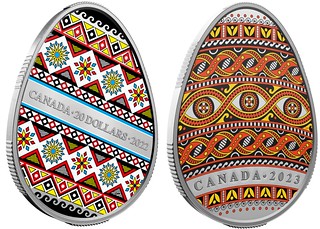 Following Russia's invasion of Ukraine in February 2022, the Royal Canadian Mint made the decision to donate all net cash proceeds from the sale of its Pysanka-themed collector coins to humanitarian relief for Ukrainians impacted by the war. Later that year, the Government of Canada asked the Mint to also direct net cash proceeds from the sale of its 2022 50th Anniversary of the Summit Series and the 2023 Pysanka collectibles to the same cause. In alignment with the Government of Canada's efforts to support the people of Ukraine, the Mint has so far raised over $1 million for relief efforts led by the Red Cross Ukraine Humanitarian Crisis Appeal and the Ukrainian Humanitarian Appeal.
Following Russia's invasion of Ukraine in February 2022, the Royal Canadian Mint made the decision to donate all net cash proceeds from the sale of its Pysanka-themed collector coins to humanitarian relief for Ukrainians impacted by the war. Later that year, the Government of Canada asked the Mint to also direct net cash proceeds from the sale of its 2022 50th Anniversary of the Summit Series and the 2023 Pysanka collectibles to the same cause. In alignment with the Government of Canada's efforts to support the people of Ukraine, the Mint has so far raised over $1 million for relief efforts led by the Red Cross Ukraine Humanitarian Crisis Appeal and the Ukrainian Humanitarian Appeal.
"When Putin launched his illegal and full-scale invasion of Ukraine, Canada immediately responded, alongside our allies, by sanctioning Russia and Belarus and providing Ukraine with the economic, military and humanitarian support it needs to defend its sovereignty and democracy," said The Honorable Chrystia Freeland, Deputy Prime Minister and Minister of Finance. "Across Canada, citizens, community groups, and businesses have supported Canada's efforts to help the people of Ukraine in their fight for their lives, their country, and democracy."
"Canada is home to the world's second largest Ukrainian diaspora, and for years, the Mint has proudly honoured their rich cultural heritage through a best-selling series of Pysanka-themed collector coins," said Marie Lemay, President and CEO of the Royal Canadian Mint. "When Ukraine was invaded last year, the Mint promptly made the decision to make a donation through the sale of its Pysanka-themed coins and gladly accepted the Government of Canada's request to do the same with the 2022 Summit Series and 2023 Pysanka collectible coins."
Net cash proceeds from the sale of the following collector products allowed the Mint to make its donation:
- The 2022 and 2023 $20 Fine Silver Coins – Pysanka;
- The 2022 and 2023 $250 Pure Gold Coins – Pysanka;
- The 2022 $2 Colourized Special Wrap Roll – 50th Anniversary of the Summit Series;
- The 2022 Special Wrap Roll Set – 50th Anniversary of the Summit Series;
- The 2022 2 oz. Pure Silver Coin – 50th Anniversary of the Summit Series; and
- The 2022 $200 Pure Gold Coin – 50th Anniversary of the Summit Series.
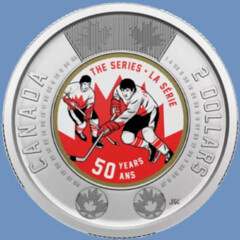 While all 2022 and 2023 Pysanka products are now sold out, the Summit Series collectibles are still available by contacting the Mint at 1-800-267-1871 in Canada, 1-800-268-6468 in the US, or online at www.mint.ca/summitseries. They can also be purchased at the Royal Canadian Mint's Ottawa and Winnipeg boutiques, as well as through the Mint's global network of dealers and distributors.
While all 2022 and 2023 Pysanka products are now sold out, the Summit Series collectibles are still available by contacting the Mint at 1-800-267-1871 in Canada, 1-800-268-6468 in the US, or online at www.mint.ca/summitseries. They can also be purchased at the Royal Canadian Mint's Ottawa and Winnipeg boutiques, as well as through the Mint's global network of dealers and distributors.
All additional proceeds from these products will go towards humanitarian relief for Ukraine.
To read the complete articles, see:
THE ROYAL CANADIAN MINT RAISES OVER $1 MILLION DOLLARS FOR UKRAINE HUMANITARIAN RELIEF THROUGH SALE OF PYSANKA AND 50TH ANNIVERSARY OF THE SUMMIT SERIES COLLECTIBLES
(https://www.newswire.ca/news-releases/the-royal-canadian-mint-raises-over-1-million-dollars-for-ukraine-humanitarian-relief-through-sale-of-pysanka-and-50th-anniversary-of-the-summit-series-collectibles-844572286.html)
Mint raises $1M from Pysanka coins, Summit Series for relief efforts in Ukraine
(https://canadiancoinnews.com/mint-raises-1m-from-pysanka-coins-summit-series-for-relief-efforts-in-ukraine/)
DEFACED 1942 VICHY 1 FRANC
Bill Myers published a short piece in the May 8, 2023 MPC Gram about an interesting defaced coin. -Editor
Politically Defaced?
I was rummaging through a junk box of coins and found an aluminum Vichy 1942 1 franc coin (K902.1, SB126a1) that was very worn and damaged. The junk box should have been its final resting place, but I rescued it and took it home. It was the damage that caught my eye. Someone has taken a sharp edge object like a chisel and placed grooves around the top of the double headed ax in the form of a square and a vertical line and an X inside the square.
To me it is obvious the marks were to deface the Vichy symbol. I wondered when this was done. The coin shows significant wear, and the grooves are stained black and the edges of the grooves are rounded. I feel the coin circulated after the grooves were stamped into the coin due to the wear. This have could have been done during World War II but would not have been something I would think would be smart to carry or spend this coin. It did not take much to get a visit by the Gestapo. I feel it was done after the liberation of France. France started minting coins without the Vichy ax in 1944 but until they circulated the Vichy coins would have to be used. By defacing the Vichy ax may have made the coin more acceptable.
The wear on the edges of the grooves shows that the coin circulated for a significant time after the grooves were punched into the coin. I cannot verify this is what happened to the coin but I feel it is a reasonable explanation. This coin has found its way into my collection.
The MPC Gram is an email newsletter for collectors of Military Payment Certificates and other military numismatica. To subscribe to the MPC Gram, see: https://guide.us13.list-manage.com/subscribe?u=10eb366ab80344a56657e0d5d&id=58874b37e1 . -Editor
THE BADGE OF MILITARY MERIT
This article discusses and pictures a rare predecessor to the Purple Heart medal - the Badge of Military Merit. -Editor
The road to glory in a patriot army and a free country is thus opened to all.
So said George Washington when he created the Badge of Military Merit, which he first awarded today in 1783, to two brave enlisted Connecticut soldiers at the Continental Army headquarters in Newburgh, New York.
Prior to this, awards for military distinction had been granted almost exclusively by Congress to military officers: Washington, for forcing the British to evacuate Boston; Horacio Gates's victory at Saratoga; Nathaniel Greene's victories in the Southern campaign. The only non-officers awarded medals were the three enlisted men who had captured the spy John Andre, which exposed the British plan to take over West Point and execute Washington, with the help of the traitor Benedict Arnold.
Congress had banned the practice of granting commissions or promotions as a reward for merit, so Washington decided that a formal award honoring enlisted men's bravery and exceptional service would serve as a much-needed boost in morale. Such an award had no European precedent. Washington authorized its creation, however, writing that he was ever desirous to cherish virtuous ambition in his soldiers, as well as to foster and encourage every species of Military merit.
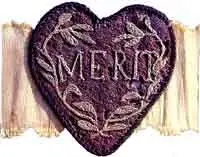 The original Badge of Military Merit, as described in Washington's General Orders, was a heart-shaped badge of purple cloth; only one surviving example still exists. The
The original Badge of Military Merit, as described in Washington's General Orders, was a heart-shaped badge of purple cloth; only one surviving example still exists. The purple heart
was intended to be sewn onto the left breast of a recipient's uniform, so others could easily see the merit badge at a glance.
The Badge of Military Merit was revived in 1932, the year of Washington's 200th birthday, by General Douglas MacArthur, who wanted to honor Washington's memory. The new medal — a heart-shaped medal featuring a profile of George Washington amid a purple enameled backdrop — was designed as a tribute to both the original Revolutionary War badge and Washington himself. Over the course of the 20th century, the criteria for earning a Purple Heart has dramatically changed. Considered to be one of the highest honors in the United States military, it is now awarded by the President of the United States to any active service member wounded or killed in action.
To read the complete article, see:
May 3: A Revolutionary Medal for the Common Soldier
(https://todayincthistory.com/2023/05/03/may-3-a-medal-for-the-common-soldier/)
KING CHARLES III CORONATION MEDAL
In April we reported on a controversy over special commemorative Coronation medals. Apparently the issue was resolved. -Editor
The King's Coronation Medal was unveiled over the weekend by the government, as was the list of people who would receive it.
More than 400,000 Coronation Medals will be distributed, according to the Culture Secretary, including everyone involved in the 6 May ceremony.
Members of the Armed Forces and frontline first responders, including police, fire, emergency services, and prison services, are also at the top of the list. To be considered, a frontline worker must have served for five full calendar years.
The Coronation Medal will act as a reminder of the important part each person has played in this moment of history,
said Culture Secretary Lucy Frazer.
For those who participated in the Coronation, the government announced that everyone, including choristers, police officers, military personnel, and St John Ambulance personnel…as well as those directly involved…
are eligible to receive the medal.
Those who have received the George Cross or the Victoria Cross and are still living are also eligible to receive the King's Coronation Medal.
The King's Coronation Medal is struck with nickel silver and plated in silver and features the profiles of King Charles III and Queen Camilla on the front. The back features the Royal Cypher, the date of the Coronation and a laurel wreath. The ribbon is red, white and blue—the colours of the United Kingdom's flag.
The King Coronation Medal was designed by Martin Jennings, who also designed King Charles's effigy for new coins.
To read the complete article, see:
Revealed: The Coronation Medal to be given to all those who took part in historic event
(https://royalcentral.co.uk/uk/king/revealed-the-coronation-medal-to-be-given-to-all-those-who-took-part-in-historic-event-189426/)
To read the earlier E-Sylum article, see:
CHARLES CORONATION MEDAL CONTROVERSY
(https://www.coinbooks.org/v26/esylum_v26n17a28.html)
KING CHARLES III ON CANADIAN MONEY
This article discusses Canada's plans to place King Charles III on their coins and banknotes. -Editor
To mark the coronation of King Charles III, Prime Minister Justin Trudeau confirmed on Saturday that Canadian coins and the $20 banknote will be updated with the new monarch's image, replacing that of his late mother, Queen Elizabeth.
Trudeau said he has asked the Royal Canadian Mint to create an effigy of His Majesty to appear on the obverse, or "heads," side of Canadian coins in circulation. He also confirmed that he has asked the Bank of Canada to update the $20 bill — the only Canadian banknote left bearing a royal's face — during its next design process.
Canada is not obligated to put the monarch on its money, but it is tradition. While the new look may be an exciting switch for people who are fond of the monarchy, history buffs or collectors of currency, many Canadians are not thrilled that King Charles is the country's head of state and may not care to see his face in their wallets.
An Angus Reid Institute poll conducted ahead of the coronation indicated that an average of just 38 per cent of respondents want to see the new sovereign on their coins and bills. Support was highest in Ontario and the Prairie provinces, and lowest in Quebec.
Sixty per cent of respondents opposed even recognizing Charles as King, according to the same poll. Only 28 per cent say they have a favourable view of Charles, while nearly half (48 per cent) did not.
Canada has been printing and minting money bearing the likeness of its sovereign since 1908, when the Royal Canadian Mint began producing coins. The Bank of Canada only began issuing banknotes in 1935.
Alex Reeves, a spokesperson for the Royal Canadian Mint, said this will be the first time any Canadian who is 65 or younger will have seen such a significant change to its change.
It's also an important moment for those working on the update. "You can't help but feel like a witness to history," he told CBC News.
The Mint will select an original portrait created by one of an "inclusive field" of artists the institution works with, he said, and, once approved by the Canadian government and Buckingham Palace, the dyes will be produced to strike the King's image on coins of each denomination, and production can begin.
Although a new minting will see hundreds of millions of coins across all denominations being produced, there will be no need to remove coins with Queen Elizabeth's effigy, as they will remain legal tender.
To read the complete article, see:
How does putting King Charles on Canadian money make people feel? It's a coin toss
(https://www.cbc.ca/news/canada/king-charles-image-money-1.6835006)
BABY BONDS
Baby Bonds are in the news again with this Wall Street Journal article discussing states considering issuing them for newborns as a way to address poverty. -Editor
A new investment program being tested in some states makes the case: what if the poorest children started life with some money in the bank.
That is the premise of a program catching on among Democratic leaders around the country. So-called baby bonds have been discussed in at least eight states and lawmakers have approved programs in Washington, D.C., Connecticut and California.
The idea is for the government to deposit a few thousand dollars into a trust account for each infant born to parents below a designated income level. As adults, the beneficiaries can use the money—plus investment returns—to help pay for education or a home.
Baby bonds were envisioned by economists Darrick Hamilton of The New School, and Duke University's William Darity Jr. Hillary Clinton floated the idea of a federal program during her 2008 presidential bid.
The proposed baby bonds are different in purpose from earlier versions numismatists may be familiar with - bonds featuring images of babies. -Editor
American Numismatic Association member Mack Martin won the Howland Wood Memorial Award for Best-in-Show in numismatic exhibiting at the 2014 Chicago World's Fair of Money in Rosemont, Illinois. Martin's exhibit, Baby Bonds,
featured notes issued in Georgia and Louisiana after the Civil War that were used to fund Reconstruction efforts.
Martin, who previously won best-in-show awards at Central States and Memphis Paper Money Show, said he began collecting Baby Bonds in 1975 .That started me collecting everything I have ever had a chance to buy,
he said.
For Martin, the fun of collecting Baby Bonds is researching the history behind them through archived records. Only two states in the South, Georgia and Louisiana, issued Baby Bonds. In Martin's home state of Georgia, the use of Baby Bonds was short-lived before the Federal Government shut the program down. Georgia Baby Bonds were likely issued for less than a year, and those that were redeemed were destroyed, which makes Georgia bonds exceedingly rare, Martin said.
Here's more information from the ANA article on Martin's exbibit. -Editor
Georgia Baby Bonds
Informally known as Baby Bonds these certificates were authorized by the Act of December 14, 1878. These six year 4% bonds had a redemption date of January 1, 1885 and paid interest via six 4% interest coupons which were clipped from the bond annually during its life. The coupons are worth 20 cents and payable yearly by the state treasury office in the cities of Albany, Americus, Athens, Augusta, Columbus, La Grange, Macon, Savannah, and Rome. Signed by the treasurer John W. Renfroe and the Governor Alfred H. Colquitt. This $5 bond dated January 1st, 1879 has an imprint American Bank Note Company of New York. The image of baby Renfroe Jackson is at the left and the state coat of arms is at right, adjacent to the series of 6 coupons. These bonds also have a fancy ornate green back as illustrated.
Louisiana Baby Bond
Right after the Civil War in order to avoid US currency taxes, Louisiana came out with the "Baby Bond." Although it was a bond it was used as currency. A nice vignette of baby in bonnet, these bonds were affectionately called "baby bonds" because of the baby on each bond plus the small denomination of $5 which allowed many individuals to purchase them and help the state of Louisiana during the period of reconstruction after the Civil War.
To read the complete WSJ article (subscription required), see:
Could $3,200 ‘Baby Bonds' Help End Poverty in America?
(https://www.wsj.com/articles/could-the-government-help-end-intergenerational-poverty-with-3-500-for-each-child-b6845c56)
To read the earlier E-Sylum article and the original ANA piece, see:
NOTES FROM E-SYLUM READERS: AUGUST 31, 2014
(https://www.coinbooks.org/esylum_v17n36a07.html)
Exhibit featuring Reconstruction-era bonds wins Howland Wood Memorial Award
(https://www.money.org/blog/2014wfmexhibitawards)
SOUTH AFRICAN BANKNOTE SPELLING SQUABLE
New South African banknotes have drawn criticism over the spelling of a word. Found via News & Notes from the Society of Paper Money Collectors (Volume VIII, Number 47, May 9, 2023) -Editor
The new R100 banknote that was launched by the South African Reserve Bank (SARB) last week has an apparent spelling error in the Xitsonga translation of ‘Reserve bank'.
This was realised when the release of the new note caused a stir amongst some Xitsonga-speaking communities who noticed the spelling change.
The old banknotes denoted the Xitsonga spelling of Reserve Bank as ‘Bangi-Nkulu'. However, on the new R100 note, the Xitsonga translation of the Reserve Bank was changed, with the second ‘N' in Bangi-Nkulu dropped. The word now reads as Bangi Kulu.
The change is highlighted on the specimen below.
However, the Pan South African Language Board, responsible for the translation, says the extra ‘N' was incorrect on the old notes – explaining that the ‘N' is only used when referring to a person and not an institution.
There is a Xitsonga dialect spoken in the Malamulele area in the Limpopo province which doesn't use the ‘N' – even when it is supposed to be used – but other Xitsonga-speaking communities disagree with the change.
These other communities said that this explanation for the change is wrong, and removing the ‘N' changes the whole meaning of the word – blaming the lack of consultation with language experts as the real cause of the misspelling.
Many members of the Xitsonga-speaking communities are calling for the Reserve Bank to revert to the old spelling, adding that it represents a very small dialect within the Xitsonga language (Malamulele area) and is not representative of the larger community.
Apart from the spelling error, the new banknotes also came with enhanced security features and new designs celebrating the country's heritage.
To read the complete article, see:
Spelling error flagged on new South African banknotes
(https://businesstech.co.za/news/finance/686369/spelling-error-flagged-on-new-south-african-banknotes/)
LOOSE CHANGE: MAY 14, 2023
Here are some additional items in the media this week that may be of interest. -Editor
Researcher Roger Burdette published an interesting article on CoinWeek on how U.S. coin dies came to be numbered for identification. Here's a short excerpt - see the complete article online for much more. Great example of the new information found in the National Archives, as discussed a few weeks ago. -Editor
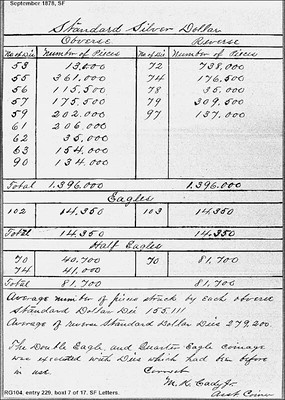 The earliest United States Mint dies were anonymous lumps of steel. Except for the design faces and size, there was little to distinguish one from another. That began to change when branch mints were opened in New Orleans, Charlotte, and Dahlonega. Sometimes the Coining Department in Philadelphia, where working dies were made, marked the shank (the cylindrical part of a die) to show which mint it was intended for – but sometimes this was omitted.
The earliest United States Mint dies were anonymous lumps of steel. Except for the design faces and size, there was little to distinguish one from another. That began to change when branch mints were opened in New Orleans, Charlotte, and Dahlonega. Sometimes the Coining Department in Philadelphia, where working dies were made, marked the shank (the cylindrical part of a die) to show which mint it was intended for – but sometimes this was omitted.
Engraver James B. Longacre was the first to officially imply that dies be numbered or otherwise marked so that a record could be kept. The basic purpose was to ensure that all dies got to the correct mint, and that the engraver had a list of dies made from his hubs and master dies. At the end of the calendar year, each mint reported the quantity of dies destroyed by denomination. This was supposed to match production and distribution records kept by the Engraving Department.
By 1878, coinage dies were being numbered – likely consecutively as they were completed and ready for use, although at present we don't have explicit documentation.
In September 1880, Mint director Horatio Burchard wrote to Philadelphia Mint Superintendent Snowden with suggestions for tighter control of dies. It's not obvious why this change was made, but a possible reason is to keep better track of the large quantities of silver dollar dies being sent to all the branch mints each year. Adding numbers to dies by order of production for each facility would have made data recording easier, and simplified reporting.
To read the complete article, see:
How Coin Dies Got Their Numbers
(https://coinweek.com/how-coin-dies-got-their-numbers/)
To read the earlier E-Sylum article, see:
MINING MINT ARCHIVES FOR RESEARCH GOLD
(https://www.coinbooks.org/v26/esylum_v26n17a13.html)
Roger Burdette discusses what seems today as a very bizarre 1859 distribution of freshly minted quarters to a group of slaves by Pierce M. Butler, whose other numismatic connection is serving as an Assay Commissioner. See the complete article on CoinWeek. -Editor
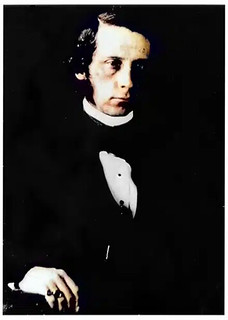 Pierce M. Butler, along with brother John, inherited a large Georgia rice plantation from their grandfather in 1822. This included 10,000 acres of rice and cotton land and almost 1,000 slaves. Pierce lived in Philadelphia leaving the plantation management to others. Between 1822 and 1856, he squandered about $700,000 plus his income from the plantations, and creditors began forced sale of his assets.
Pierce M. Butler, along with brother John, inherited a large Georgia rice plantation from their grandfather in 1822. This included 10,000 acres of rice and cotton land and almost 1,000 slaves. Pierce lived in Philadelphia leaving the plantation management to others. Between 1822 and 1856, he squandered about $700,000 plus his income from the plantations, and creditors began forced sale of his assets.
In 1858 he was selected by the president of the United States to serve on the government's annual Assay Commission of U.S. coins at the Philadelphia Mint and was present for the coinage trials. There's no record of him doing anything during the Commission's meetings, but that was not unusual for the time.
In March 1859, creditors brought to sale all of the slaves from Butler's plantations. These were sold over a two-day period at the Ten Broeck, a race track near Savannah, GA.
After the sale, in appreciation of their work and devotion to him, Pierce M. Butler personally presented – in his gloved hand, of course – each freshly sold slave four new quarter dollars – one dollar in silver, total. These coins had been procured fresh from the U.S. Mint in Philadelphia and sat in two canvas bags of $500 each on a table next to the former owner.
To read the complete article, see:
Roger Burdette: A Cynical Use of U.S. Coins
(https://coinweek.com/roger-burdette-a-cynical-use-of-u-s-coins/)
Here are a few items for bibliophiles. Len Augsburger passed along this article about a long-lost ancient manuscript. Thanks. -Editor
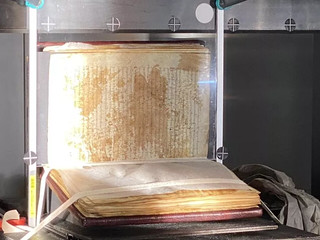 Researchers have revealed a hidden manuscript on a recycled piece of parchment, believed to have been written by the Greek mathematician, astronomer and geographer from the ancient Roman Empire: Claudius Ptolemy.
Researchers have revealed a hidden manuscript on a recycled piece of parchment, believed to have been written by the Greek mathematician, astronomer and geographer from the ancient Roman Empire: Claudius Ptolemy.
After years of painstaking work, the team, from the Sorbonne and New York Universities, have deciphered the long-lost message detailing the construction and uses of an ancient tool for tracing distances and the stars.
"The pages in the manuscript with the scarcely visible Greek text were discovered back in 1819 by Angelo Mai, but he was unable to read most of the pages," Alexander Jones, one of the lead researchers on the study, told Newsweek. "[He also] made the situation much worse for subsequent scholars by applying a chemical treatment to the pages that was supposed to bring out the writing but in fact just stained them dark brown."
In January 2020, the team began analyzing the manuscript in detail, using multispectral imaging techniques to reveal the hidden ink.
The parchment on which the manuscript had been written was found in the library of the Bobbio Abbey in Italy and is now stored at the Biblioteca Ambrosiana in Milan. "The monks of the Bobbio Abbey, where our manuscript comes from, were great recyclers of pages from disused books since parchment was always very expensive," Jones said.
To read the complete article, see:
Ptolemy's Lost Manuscript Discovered in Book Found in Medieval Abbey
(https://www.newsweek.com/ptolemy-lost-manuscript-discovered-medieval-abbey-1790809)
Pat McBride passed along this announcement, noting "In case any bibliophiles want to make a side trip during the August ANA World's Fair of Money." -Editor
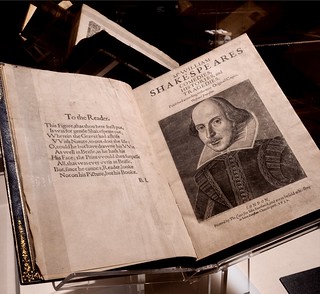 The Frick Pittsburgh, in partnership with Carnegie Mellon University
Libraries, is pleased to announce the presentation of From Stage to Page: 400 Years of Shakespeare in
Print and Inventing Shakespeare: Text, Technology, and the Four Folios, a celebration of the 400th
anniversary of William Shakespeare's First Folio. Printed in 1623, the First Folio, or Mr William
Shakespeares Comedies, Histories, and Tragedies is the earliest comprehensive compilation of
Shakespeare's works in print, and preserves some of the playwright's best-known works, including
Macbeth, The Tempest, and As You Like It. From Stage to Page offers the rare opportunity to see not only
a First Folio, one of only 230 surviving, in person, but all four of Shakespeare's folios displayed in one
room.
The Frick Pittsburgh, in partnership with Carnegie Mellon University
Libraries, is pleased to announce the presentation of From Stage to Page: 400 Years of Shakespeare in
Print and Inventing Shakespeare: Text, Technology, and the Four Folios, a celebration of the 400th
anniversary of William Shakespeare's First Folio. Printed in 1623, the First Folio, or Mr William
Shakespeares Comedies, Histories, and Tragedies is the earliest comprehensive compilation of
Shakespeare's works in print, and preserves some of the playwright's best-known works, including
Macbeth, The Tempest, and As You Like It. From Stage to Page offers the rare opportunity to see not only
a First Folio, one of only 230 surviving, in person, but all four of Shakespeare's folios displayed in one
room.
We are tremendously excited to collaborate with Carnegie Mellon University Libraries to bring this
remarkable exhibition to the Frick,
said Frick Executive Director Elizabeth E. Barker. The plays of William
Shakespeare—including those passed down to us through early publications such as the celebrated the
First Folio—continue to shape the ways in which our society thinks about and describes the world. We're
grateful to our neighbors at CMU for their support and partnership in making this exhibition possible.
To read the complete article, see:
From Stage to Page: 400 Years of Shakespeare in Print
(https://www.thefrickpittsburgh.org/Files/Admin/News-Release---From-Stage-to-Page.pdf)
The Wall Street Journal published an article about what might soon be the world's most valuable book. -Editor
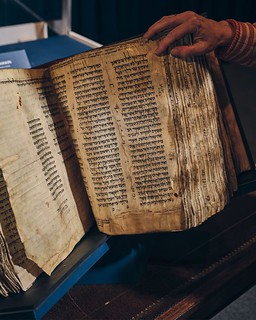 The billionaire called Sharon Liberman Mintz one day last summer and told her something that would turn her life upside down: He was ready to sell his copy of the Hebrew Bible.
The billionaire called Sharon Liberman Mintz one day last summer and told her something that would turn her life upside down: He was ready to sell his copy of the Hebrew Bible.
She understood better than anybody that this wasn't just any copy of the Hebrew Bible. It was the earliest, most complete Hebrew Bible known to exist. This roughly 1,100-year-old treasure belongs to Jaqui Safra, a financier who kept the antiquity in his collection for decades, and he wanted to put it in the hands of the pre-eminent Judaica specialist at Sotheby's.
The fingerprints of Ms. Mintz can be found all over the auction next week that could make this sacred text worth more than any book or manuscript ever sold.
Sotheby's is hoping the most precious Hebrew Bible in private hands fetches between $30 million and $50 million. At the high end, that would exceed the $43.2 million price tag on a rare copy of the U.S. Constitution auctioned in 2021.
To read the complete article (subscription required), see:
For Sale: The World's Most Expensive Hebrew Bible. Ask for Sharon.
(https://www.wsj.com/articles/hebrew-bible-auction-sothebys-codex-sassoon-67d903bc)
FEATURED WEBSITE: ENGRAVER NICOLAS SALAGNAC
This week's Featured Web Site is that of engraver and medal maker Nicolas Salagnac.
Engraver and medal maker, Meilleur Ouvrier de France, I create and produce high end punches and dies for the striking of medals and derivatives, embossing dies, business cards and letterhead, trophies, punches for cold stamping, metal sculpture and restoration of artefacts.
https://en.nicolas-salagnac.com/


